
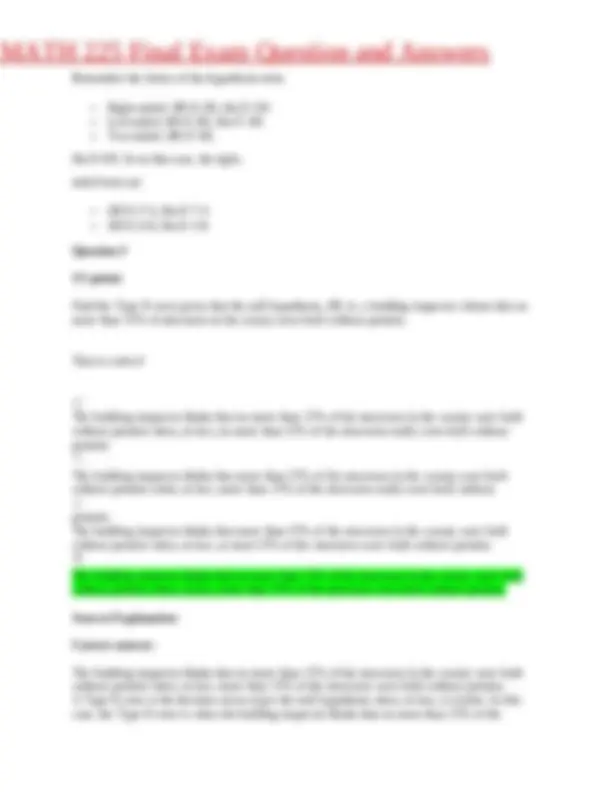
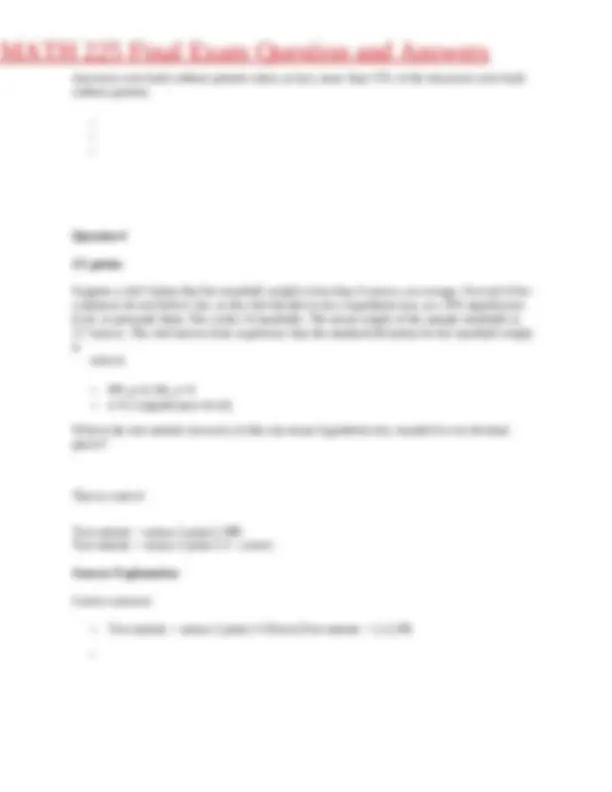
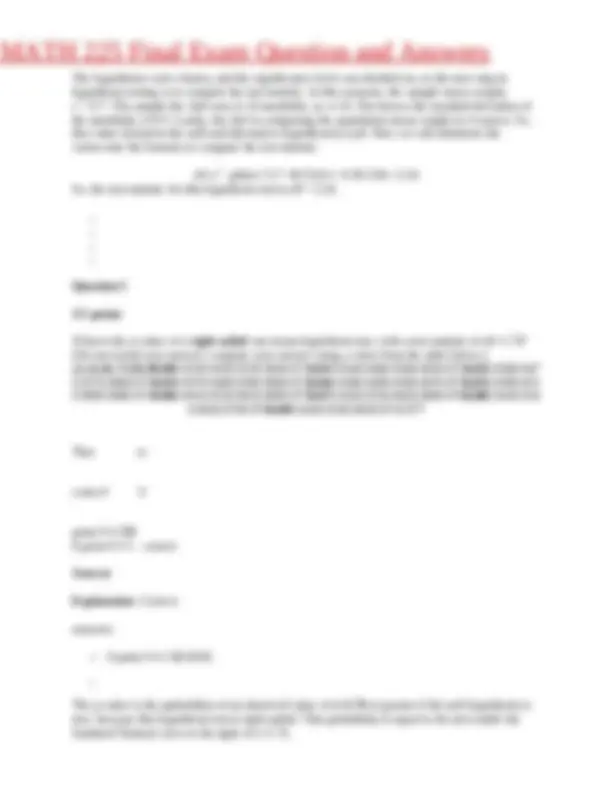
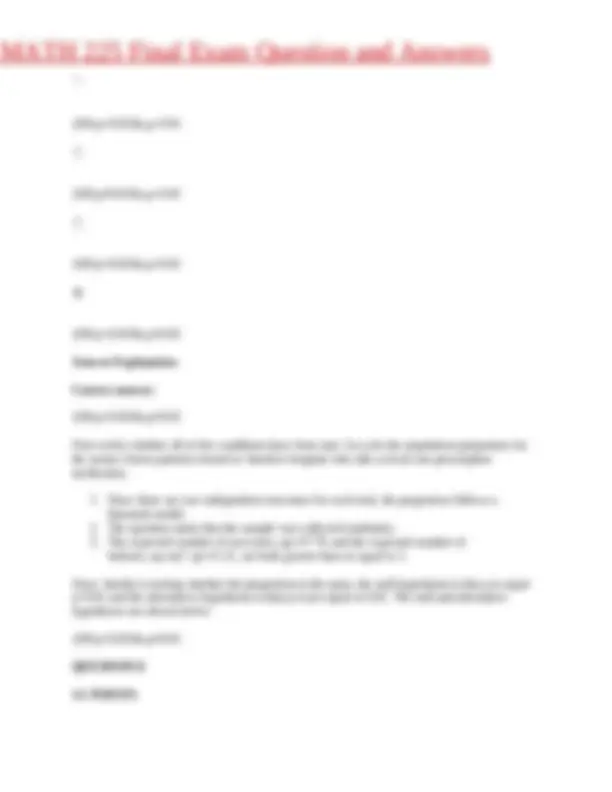
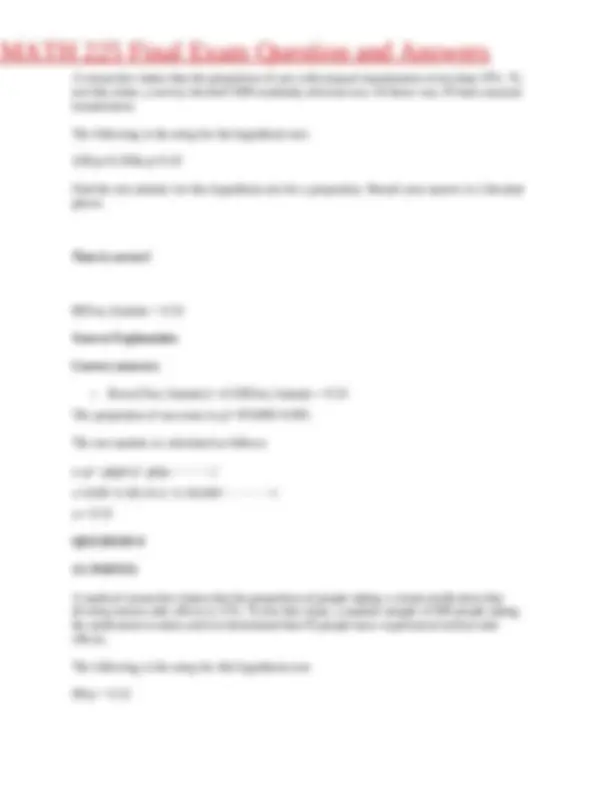
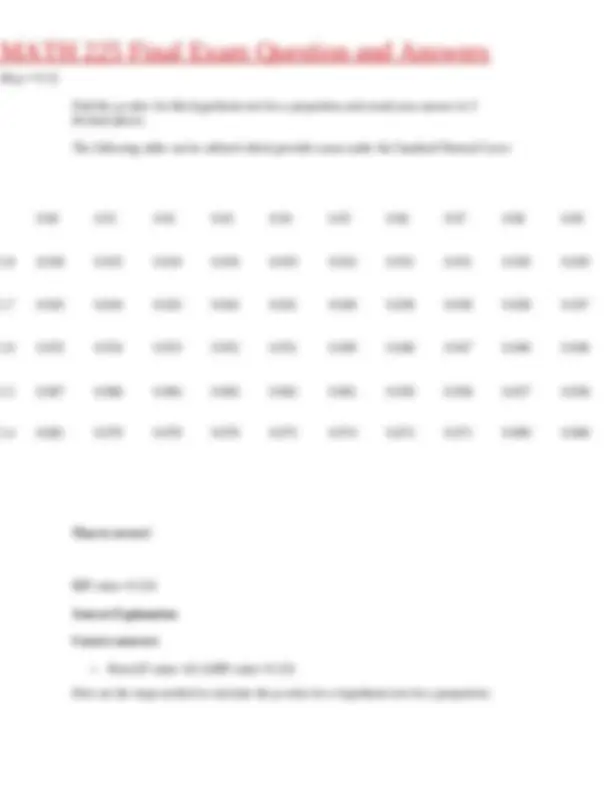
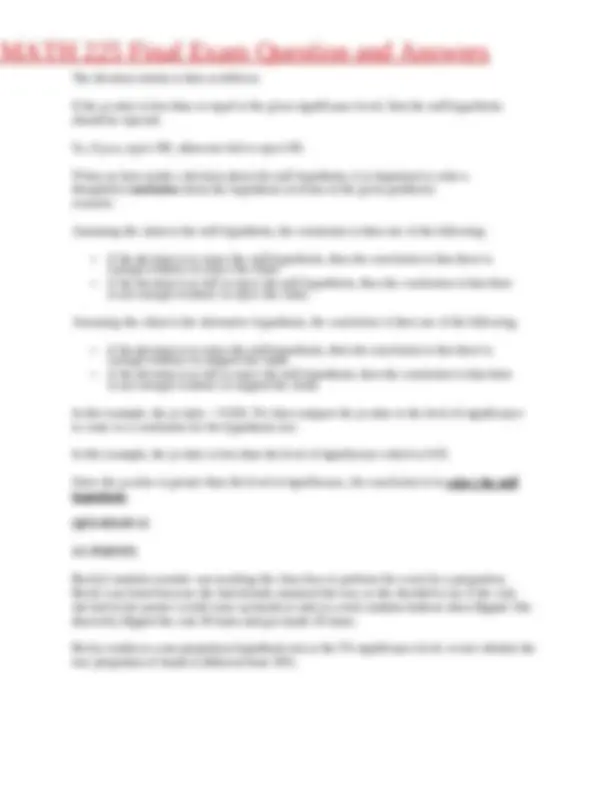
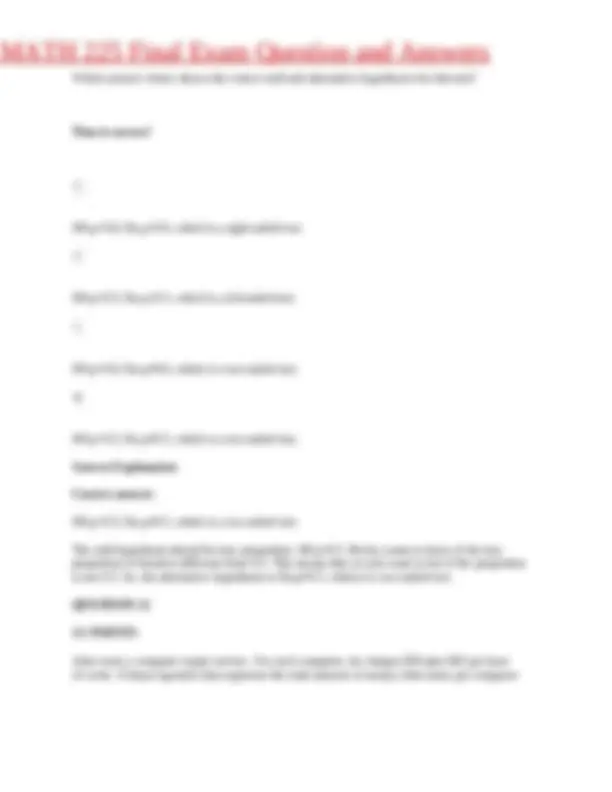
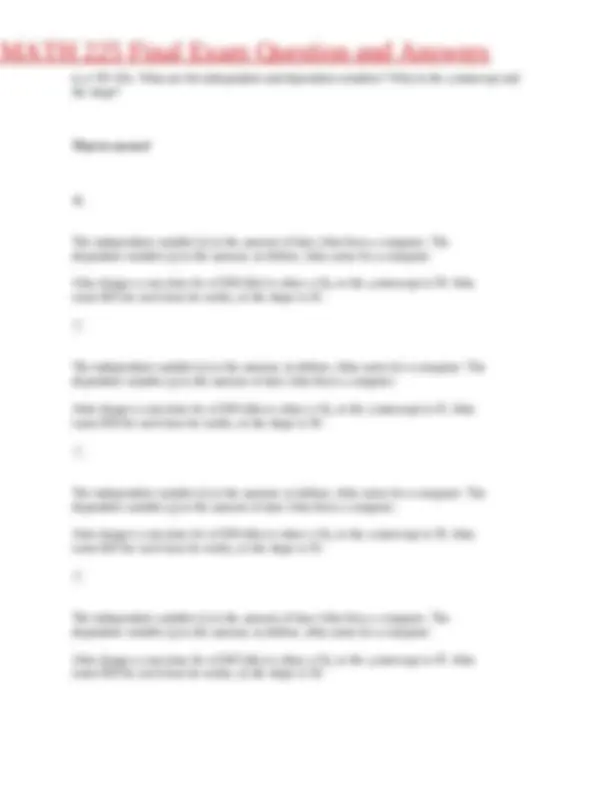
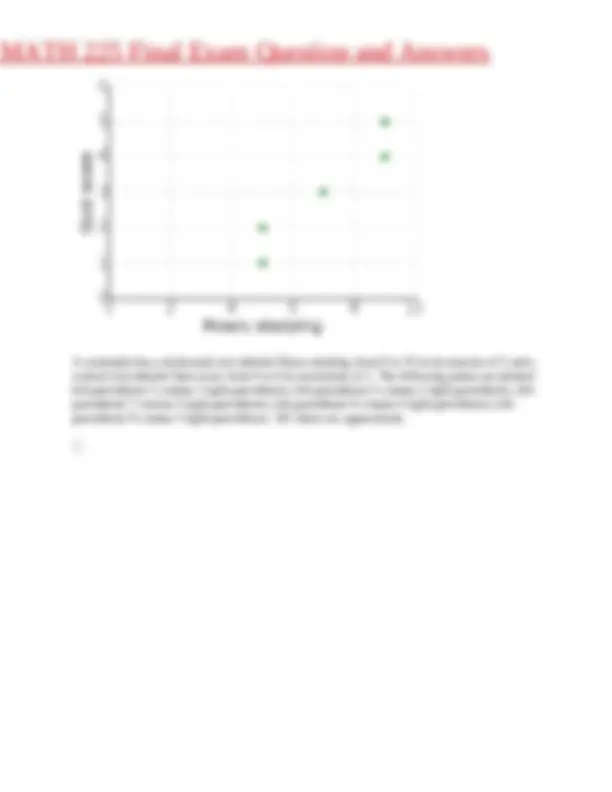
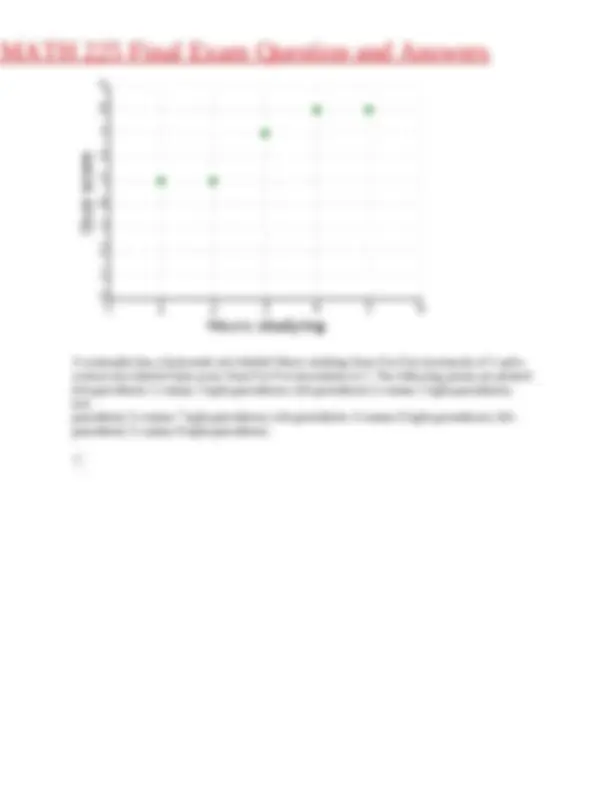
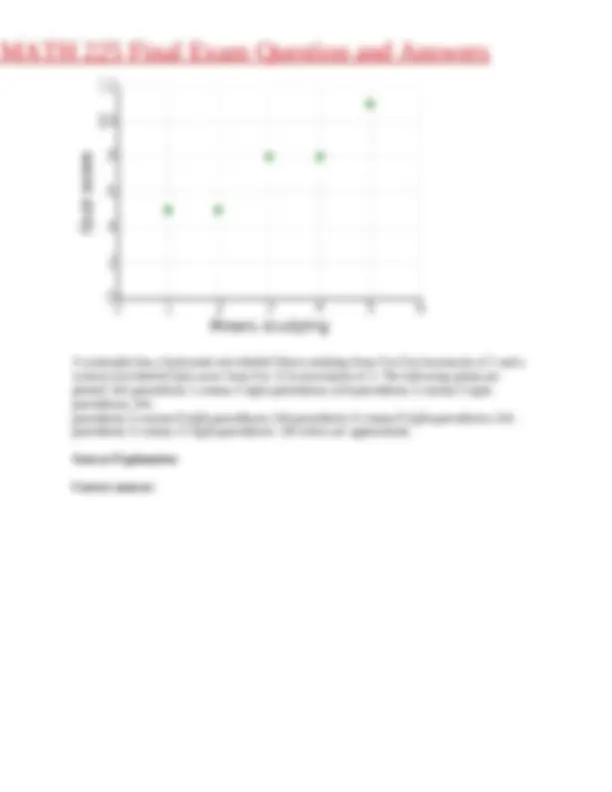
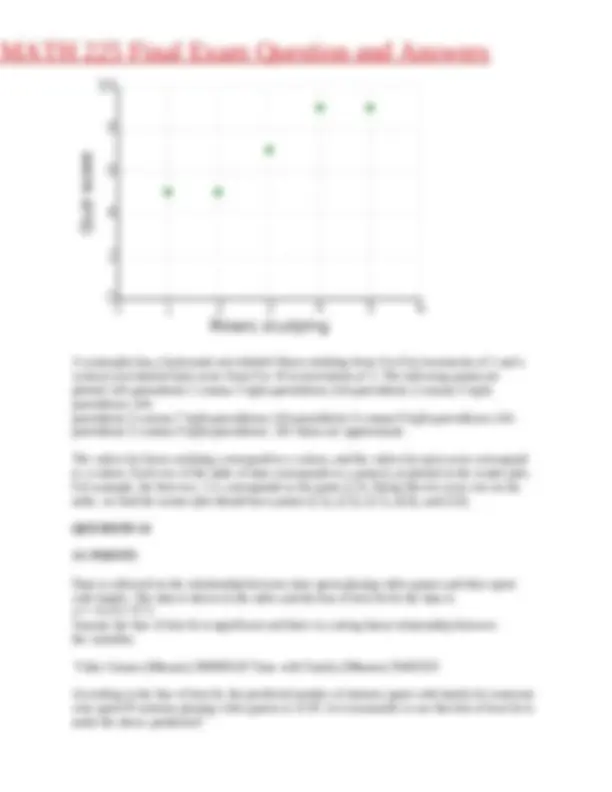
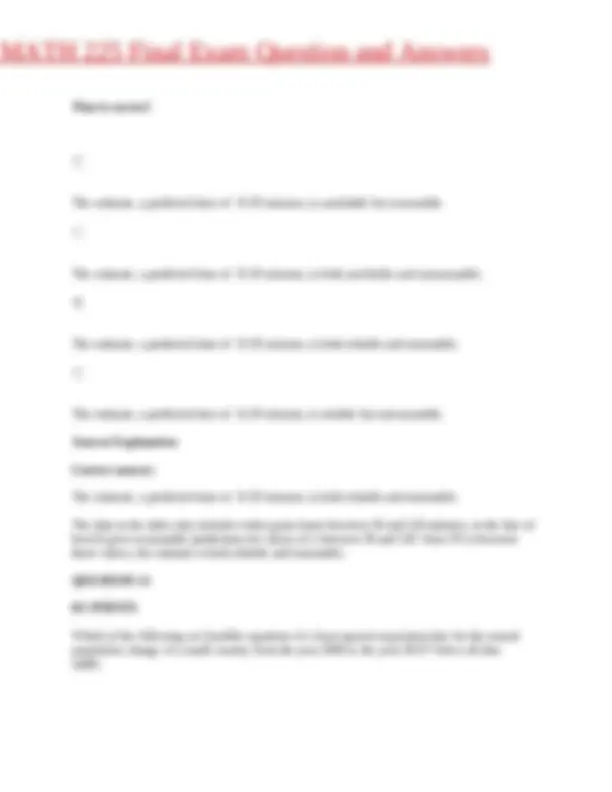
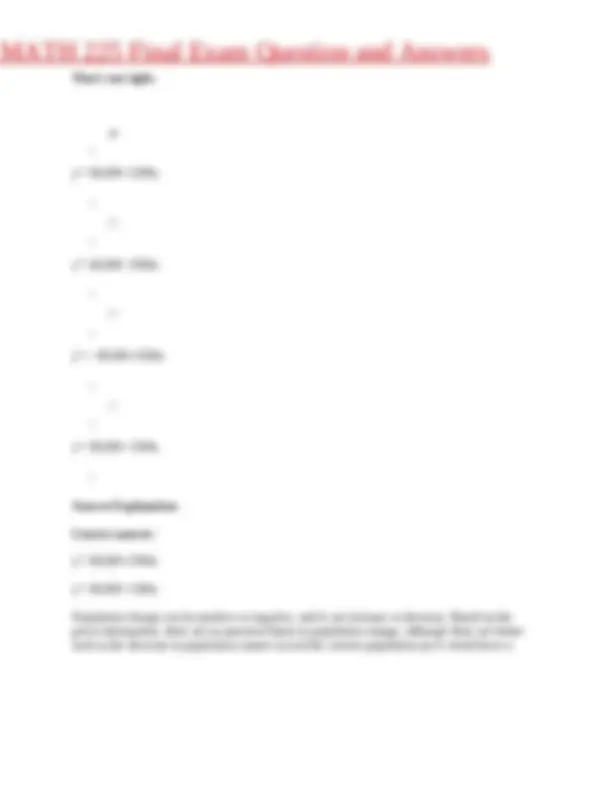
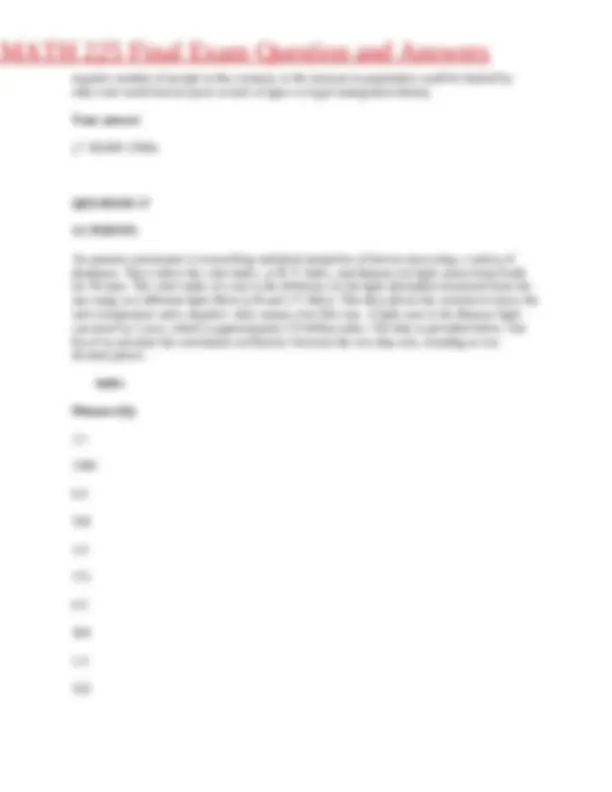
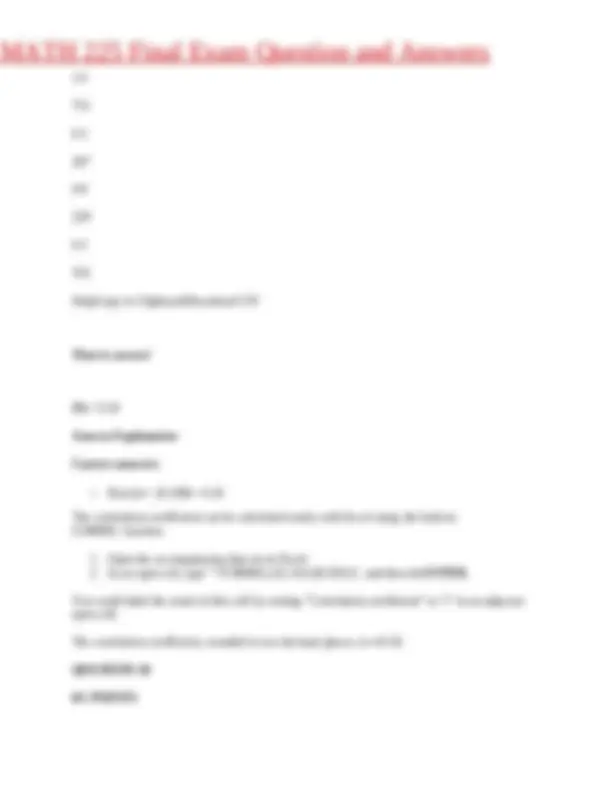
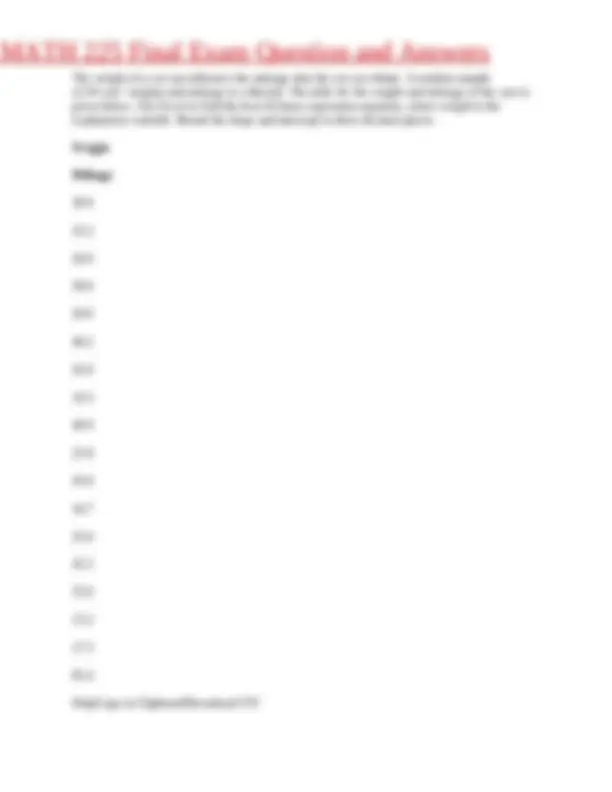
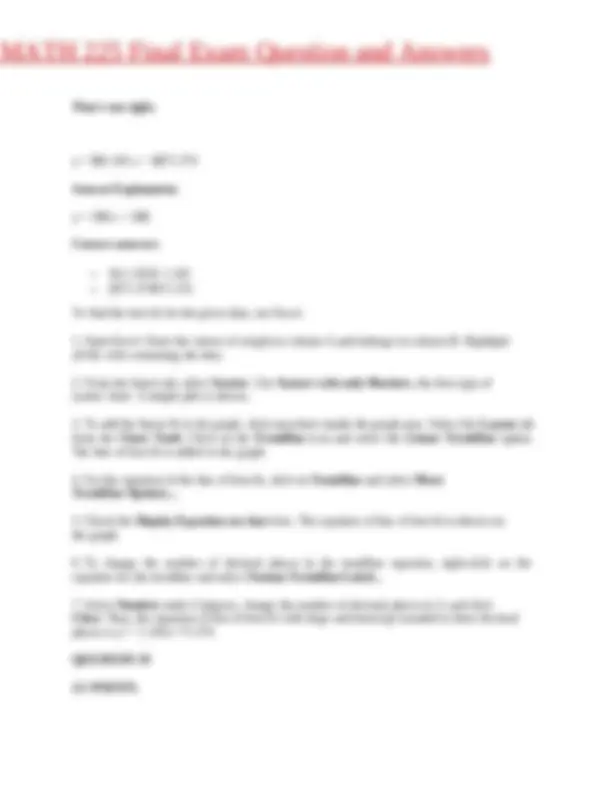
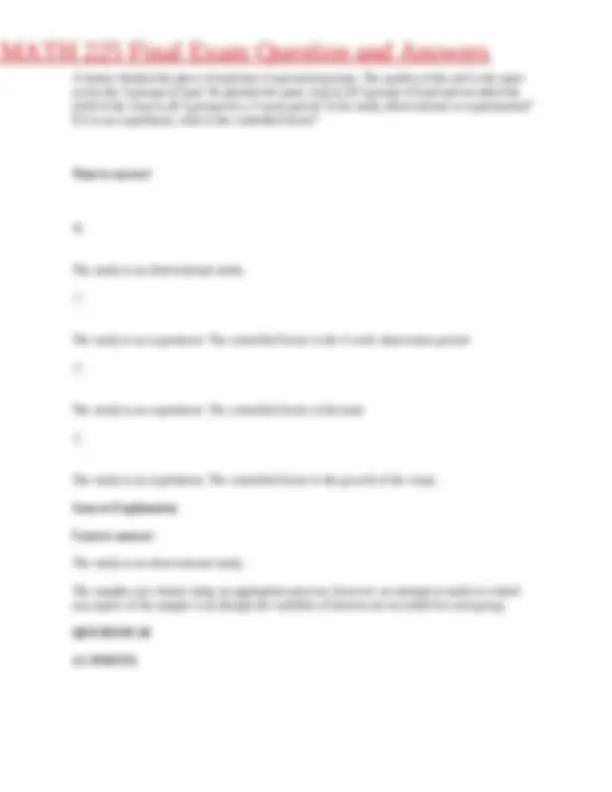
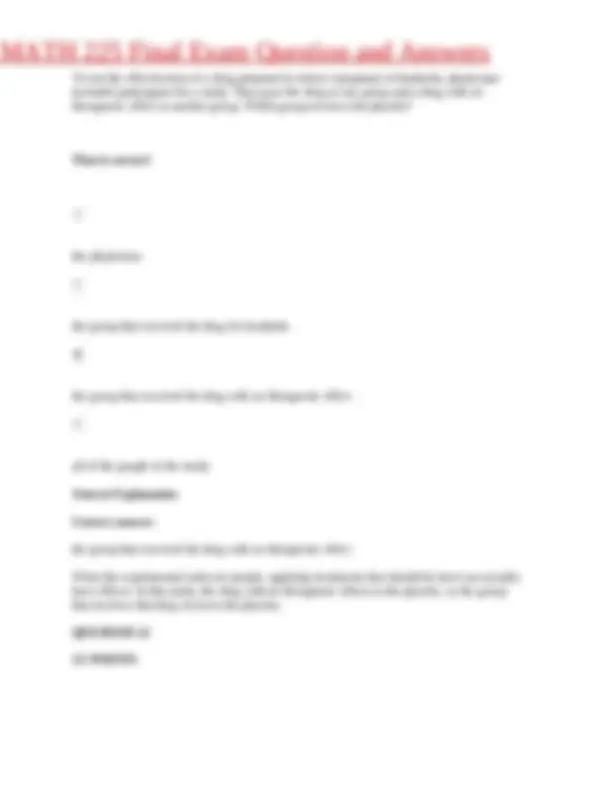
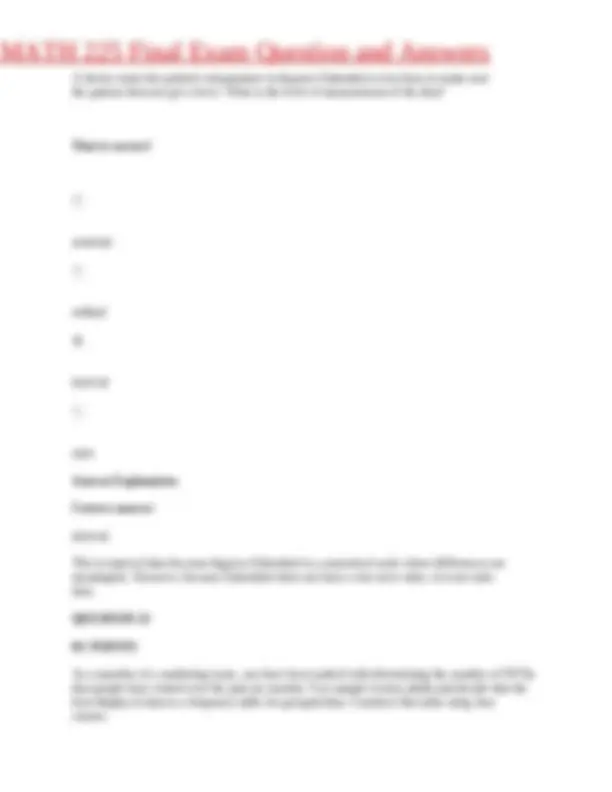
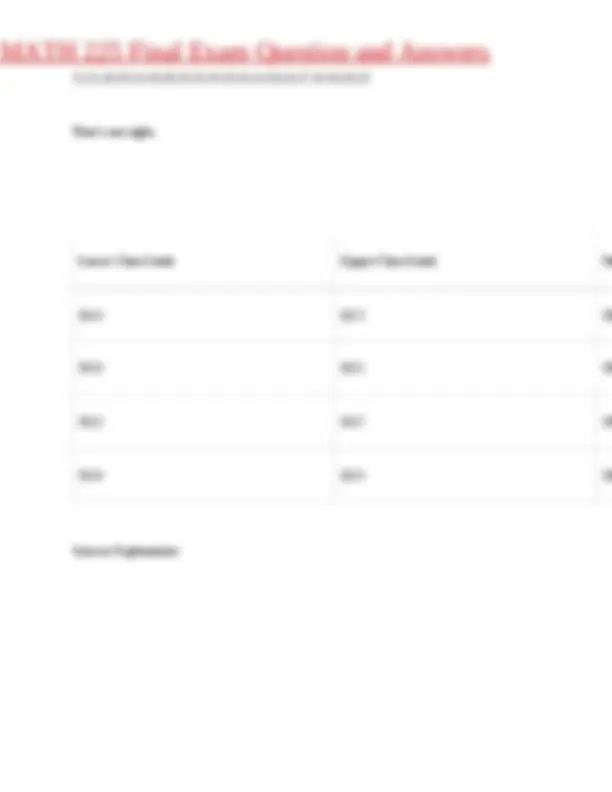
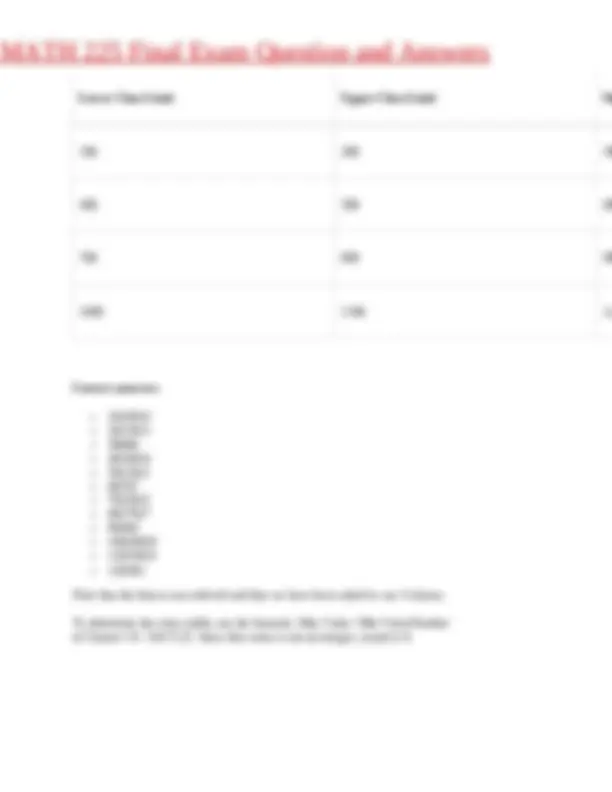
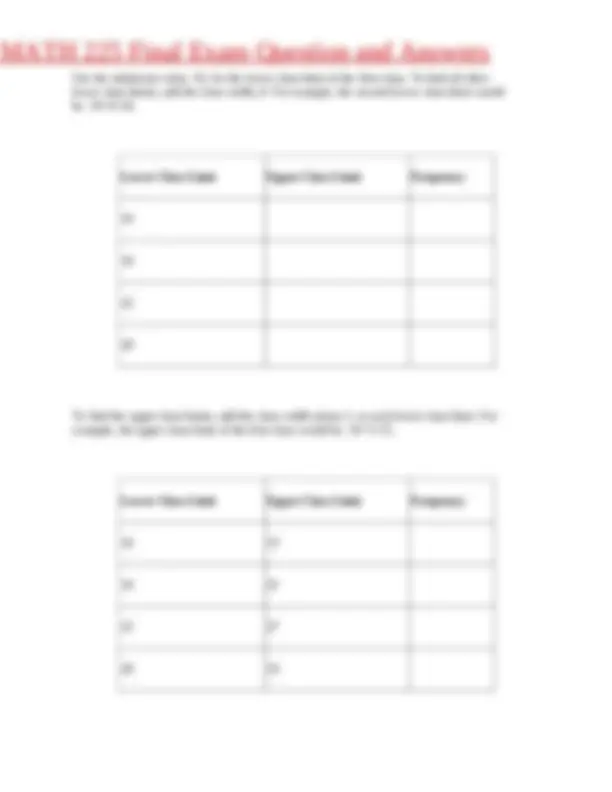
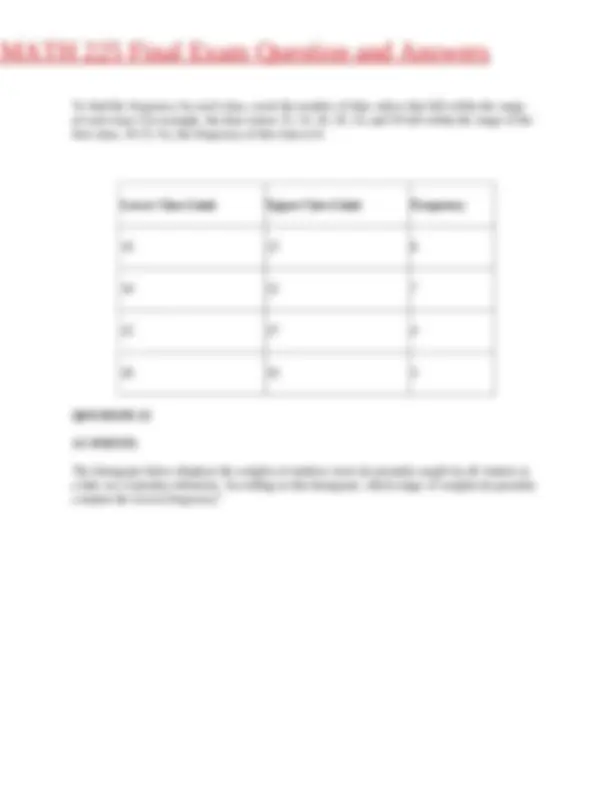
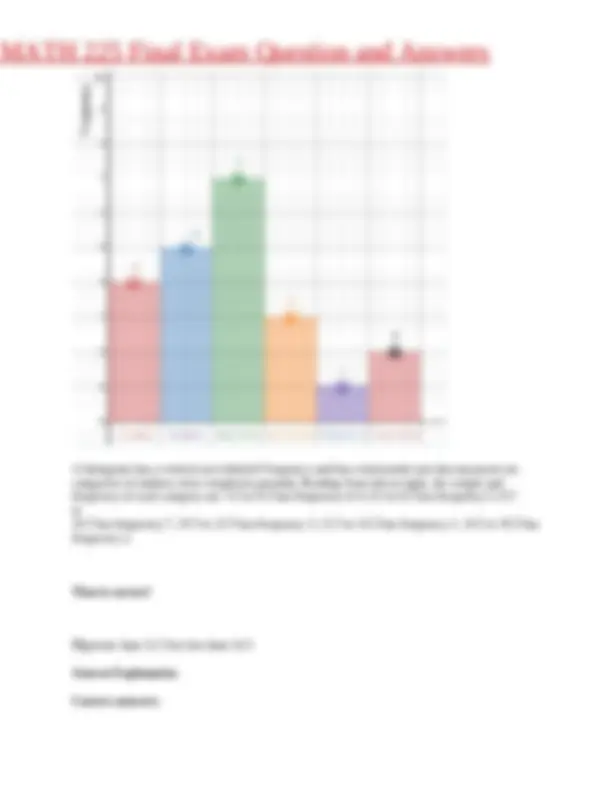
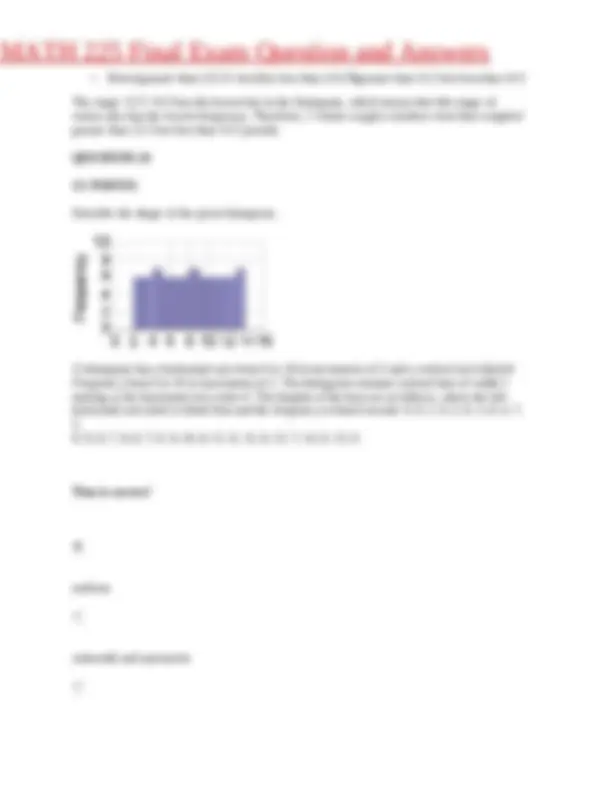
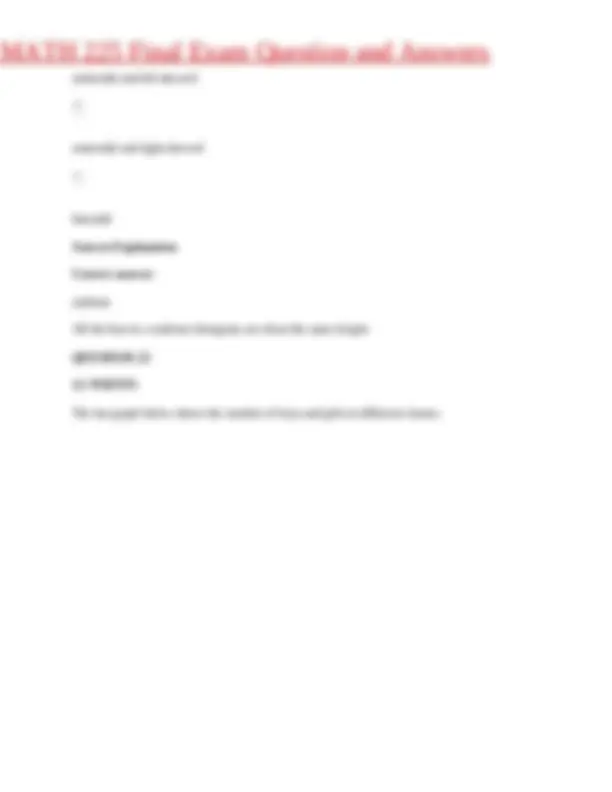
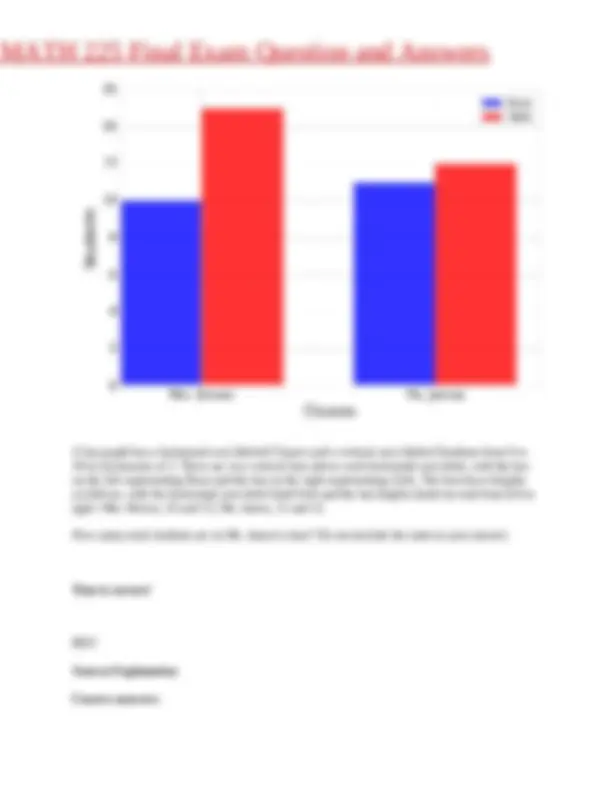
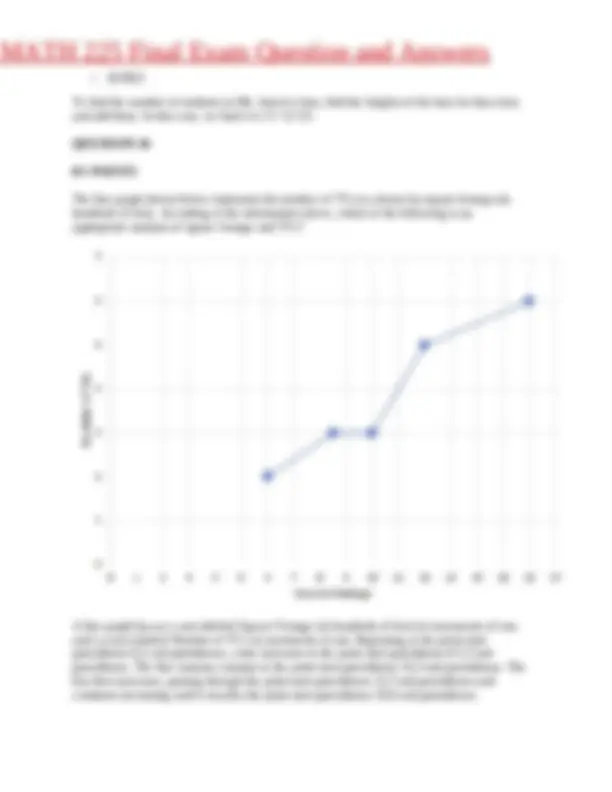
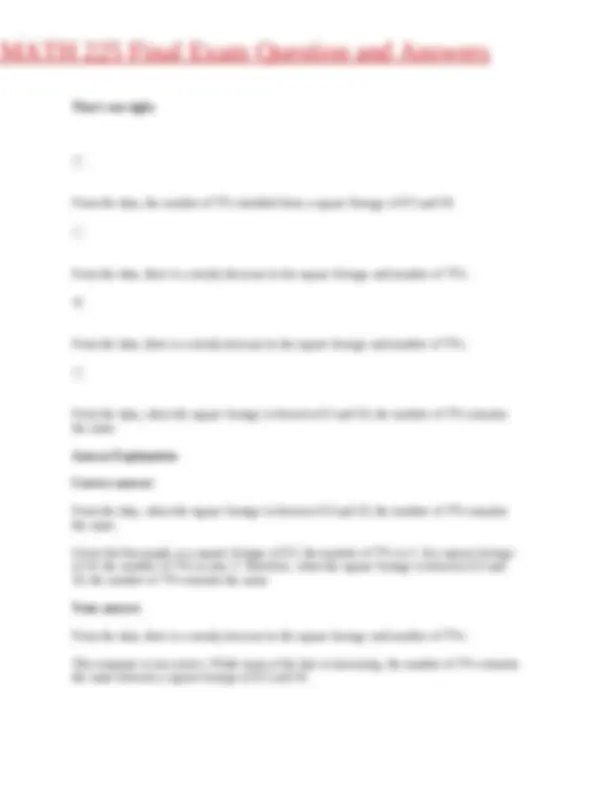
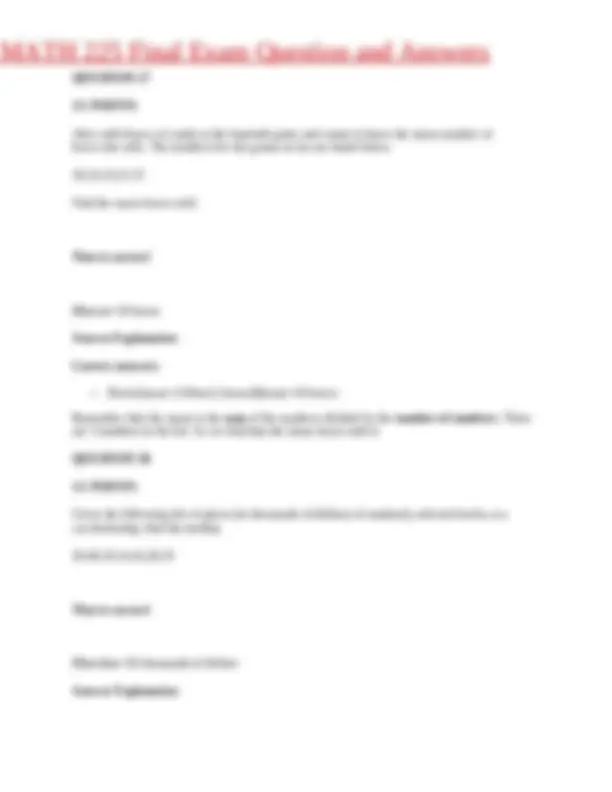
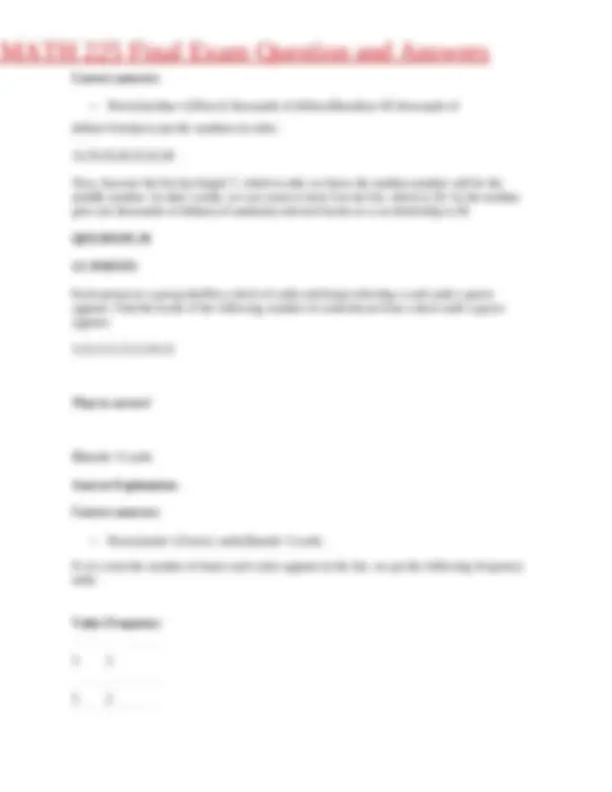
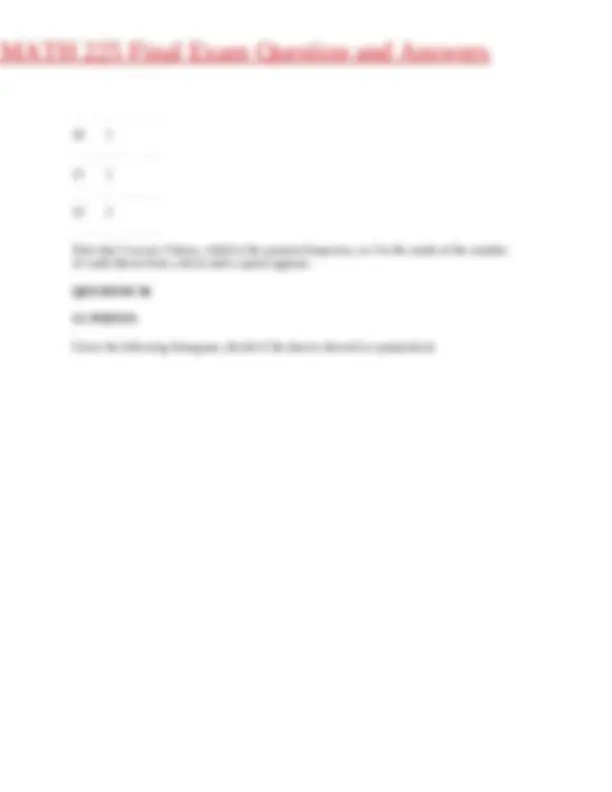
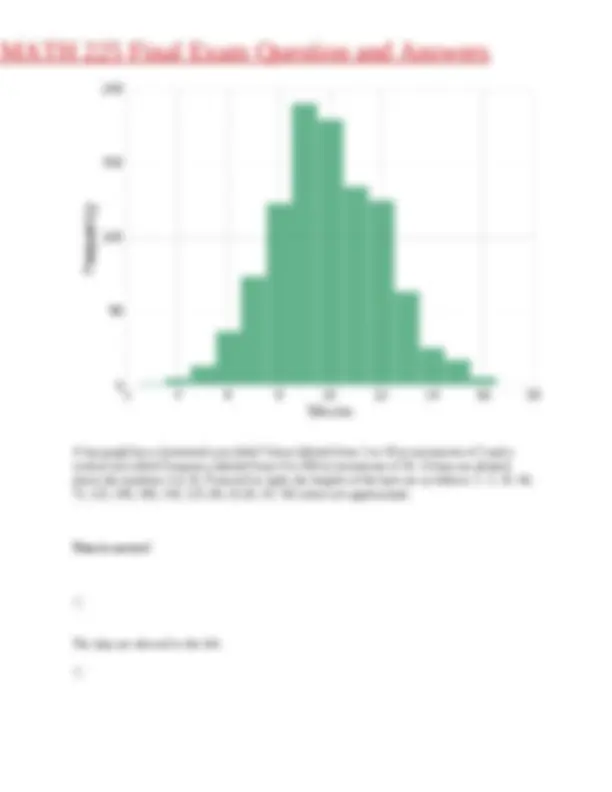
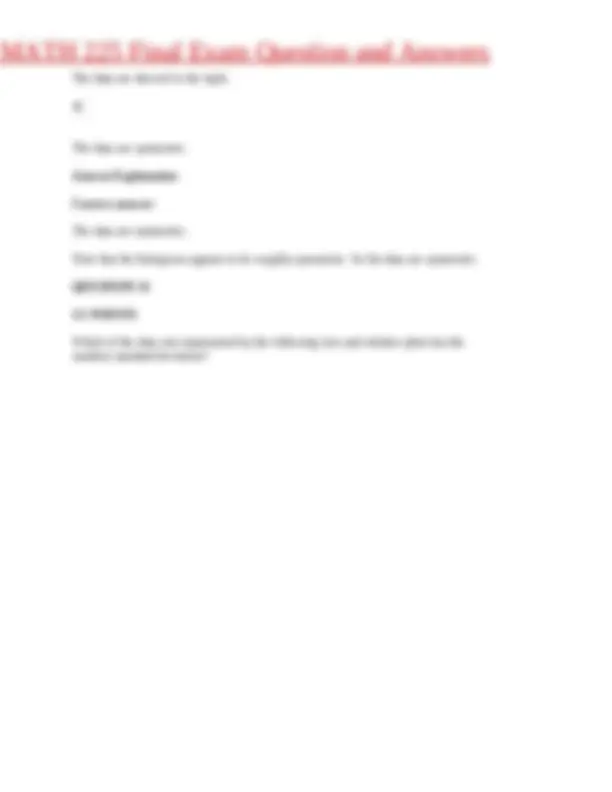
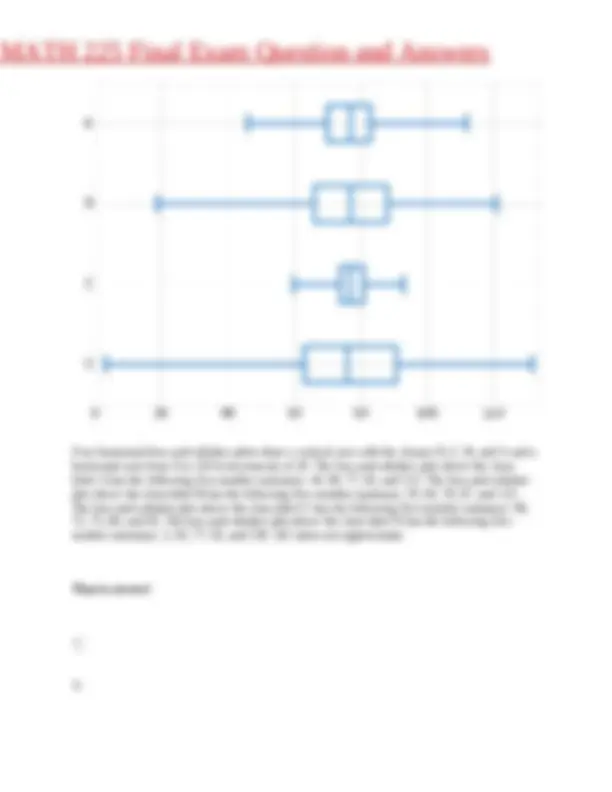
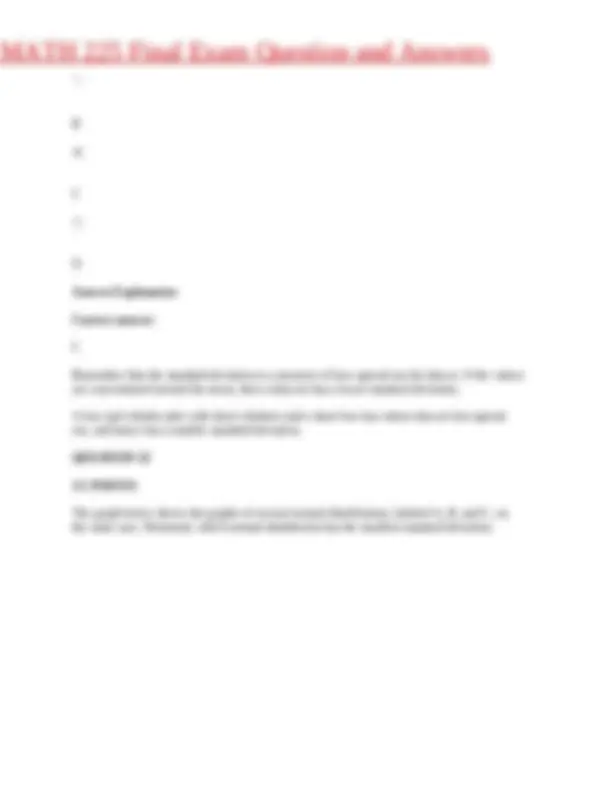
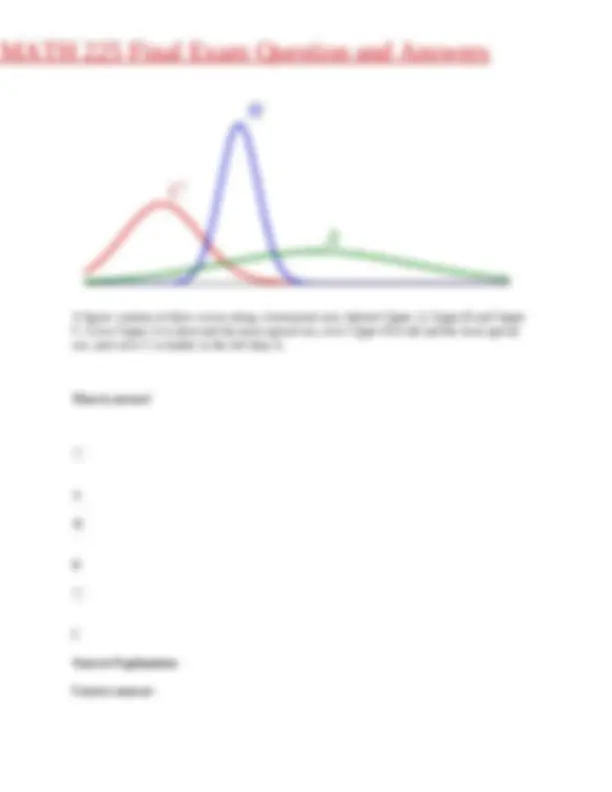
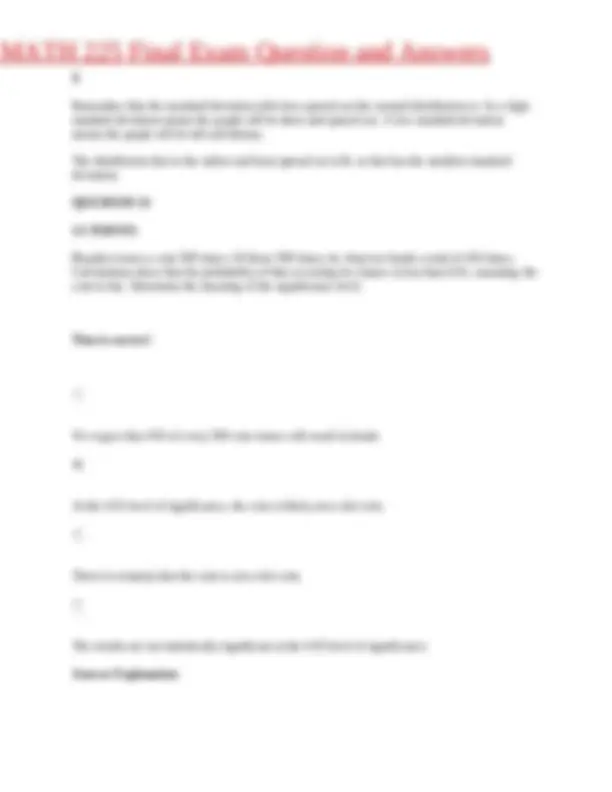
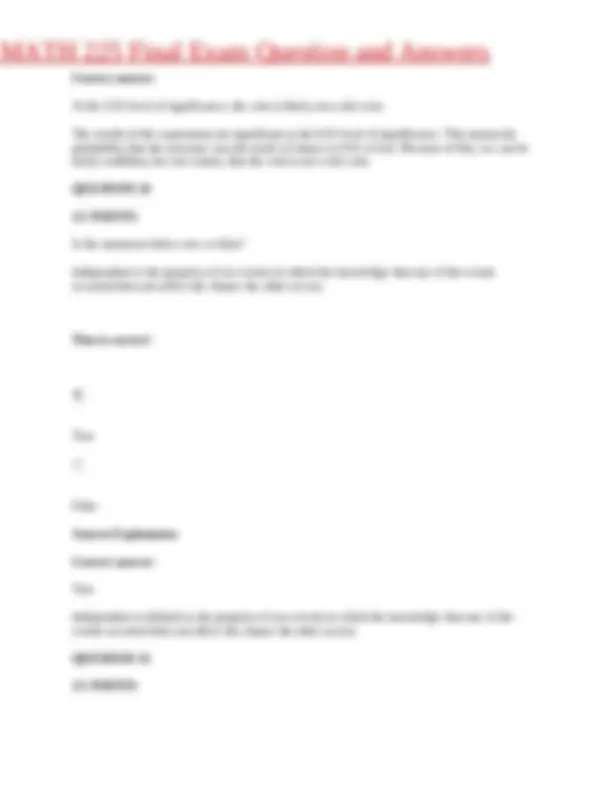
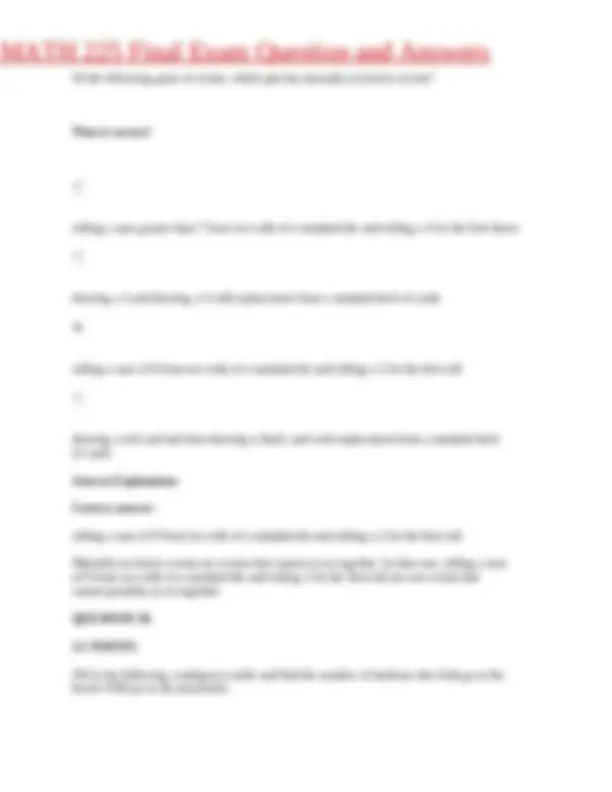
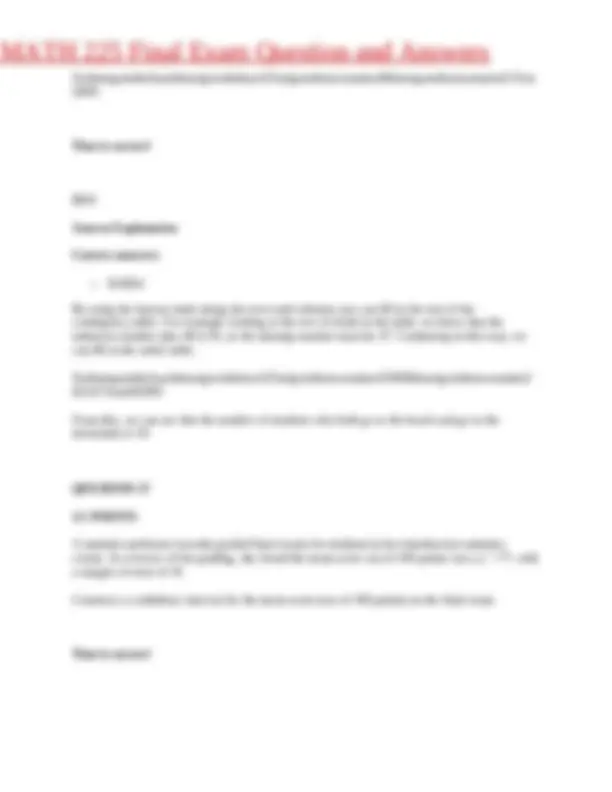
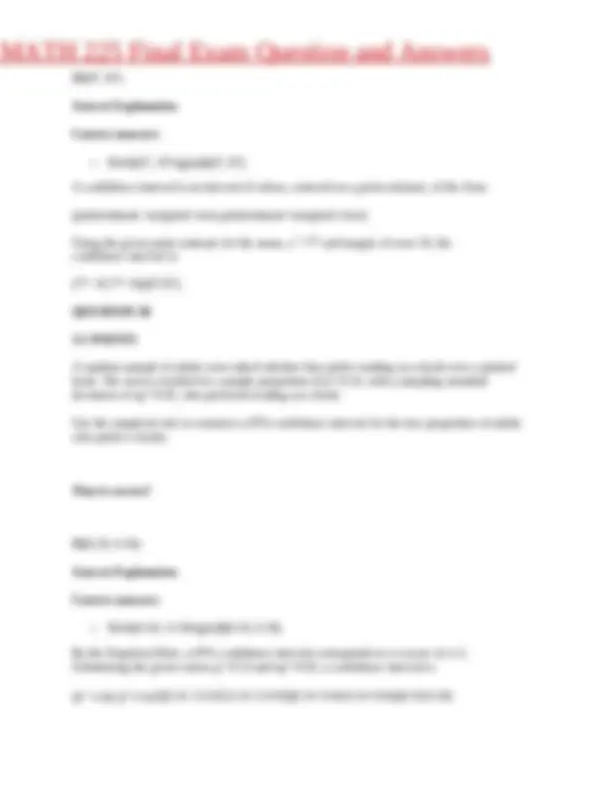
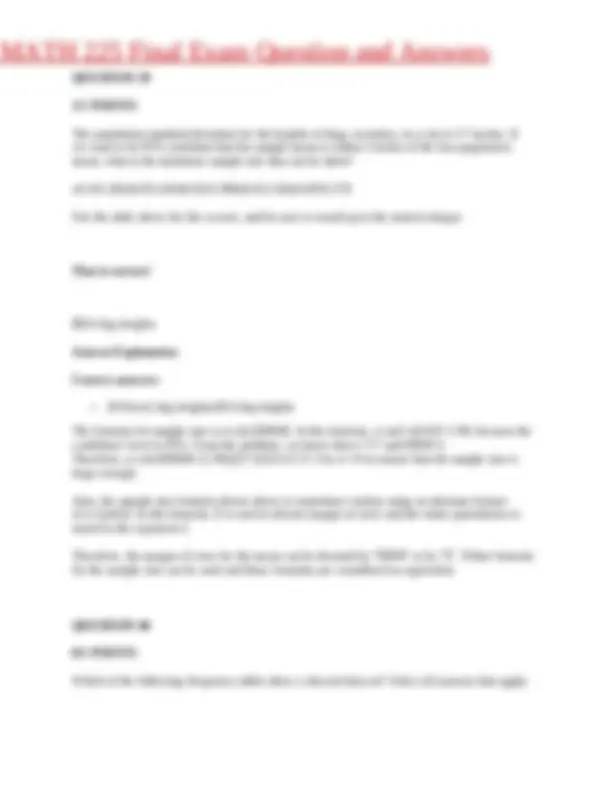
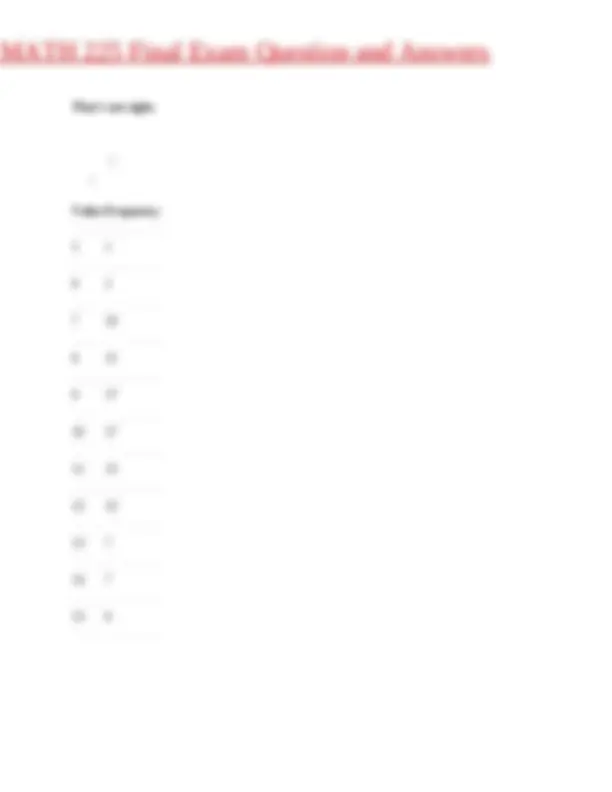
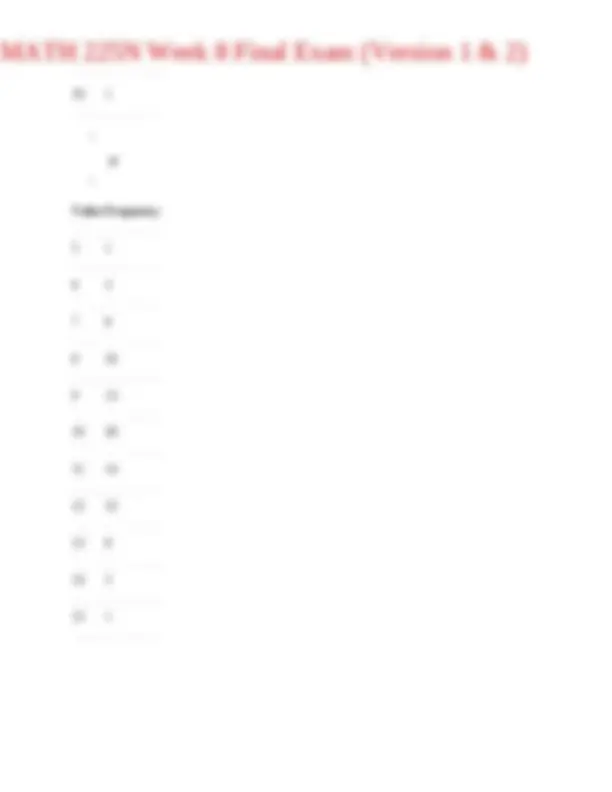
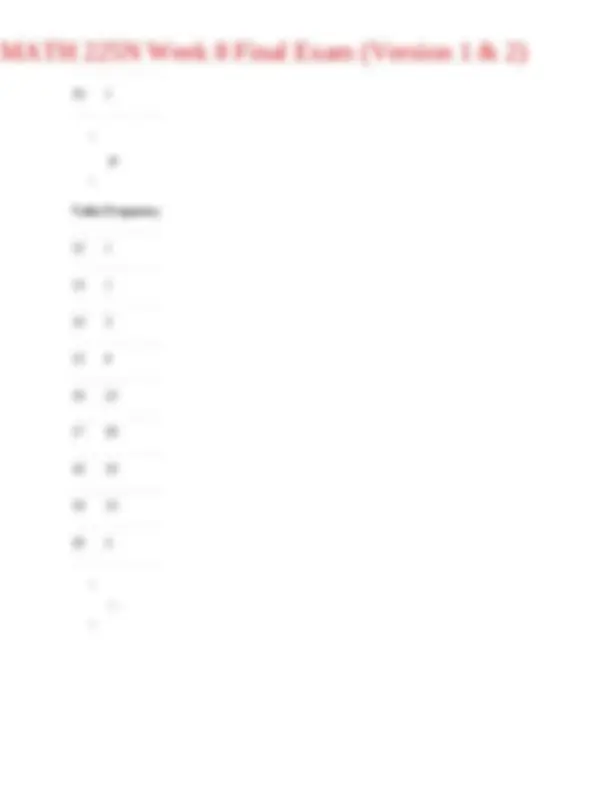
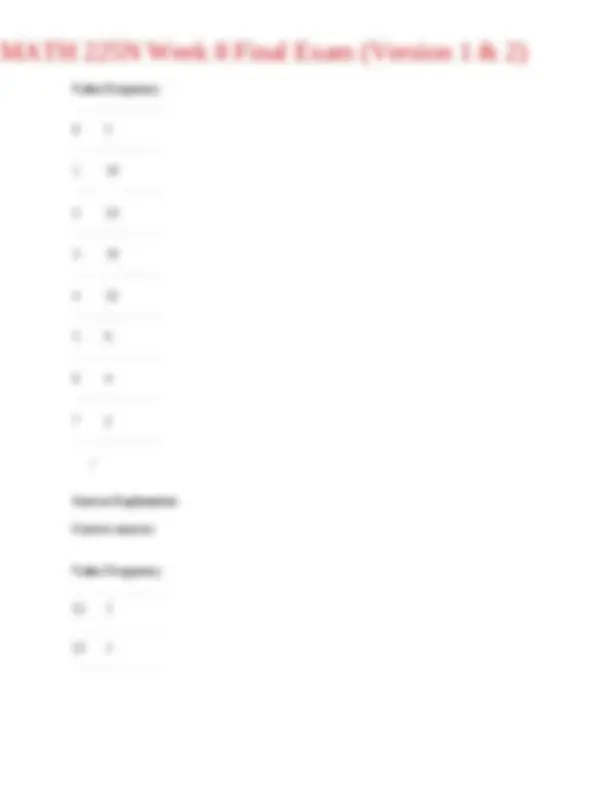
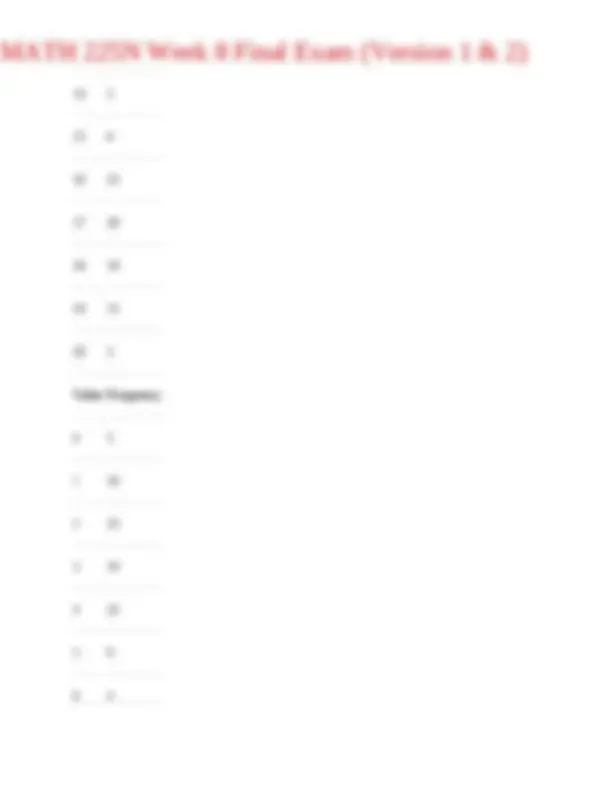
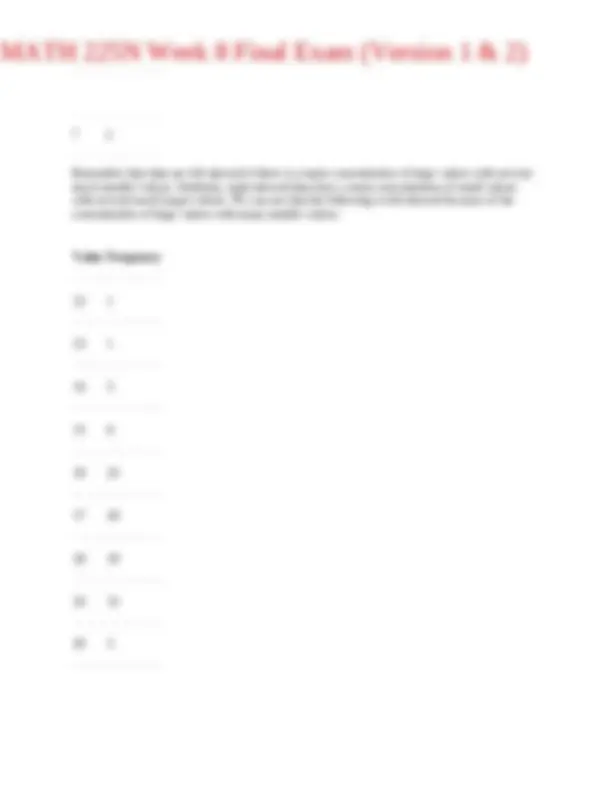
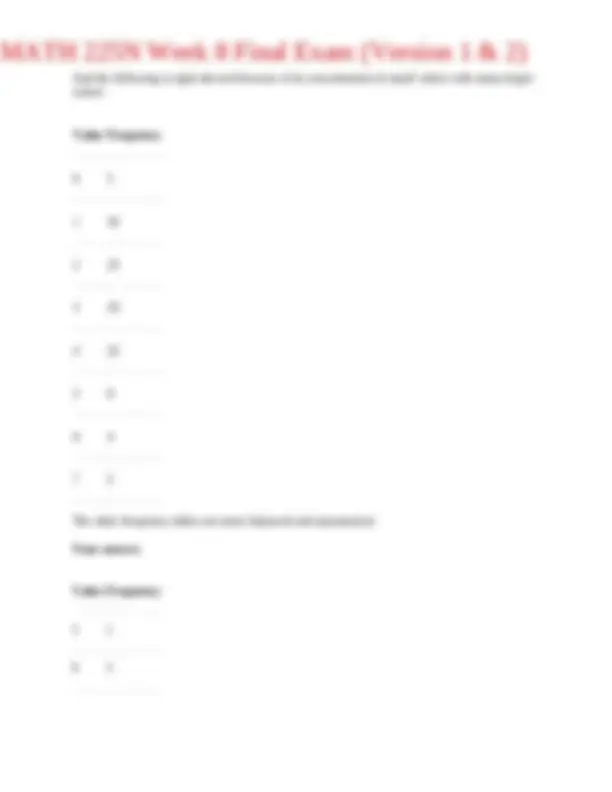
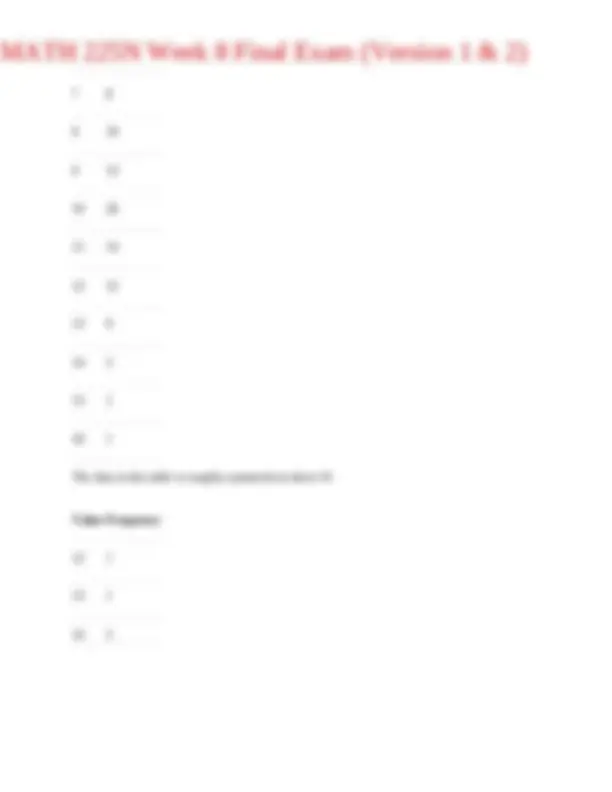
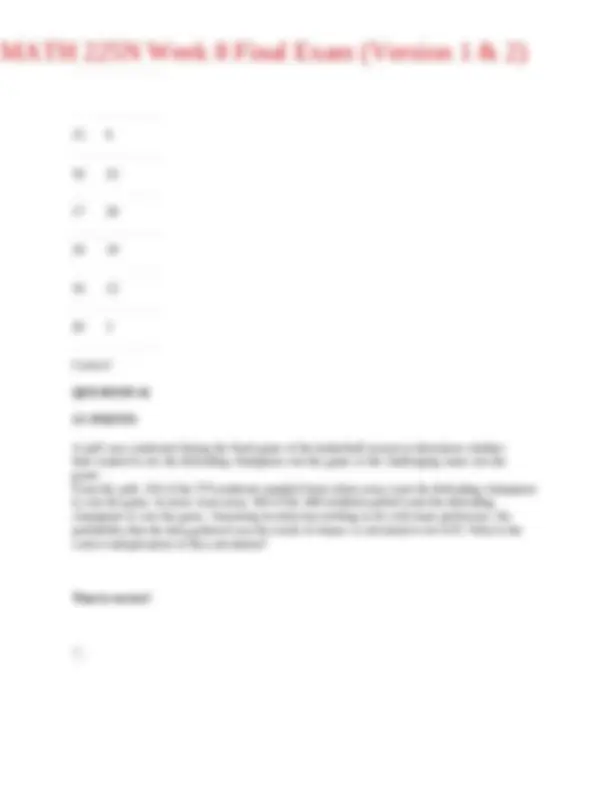
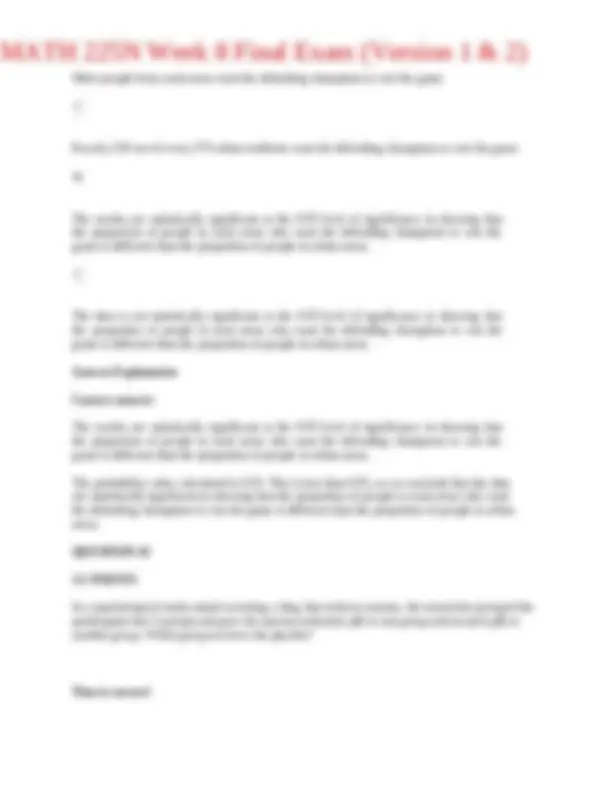
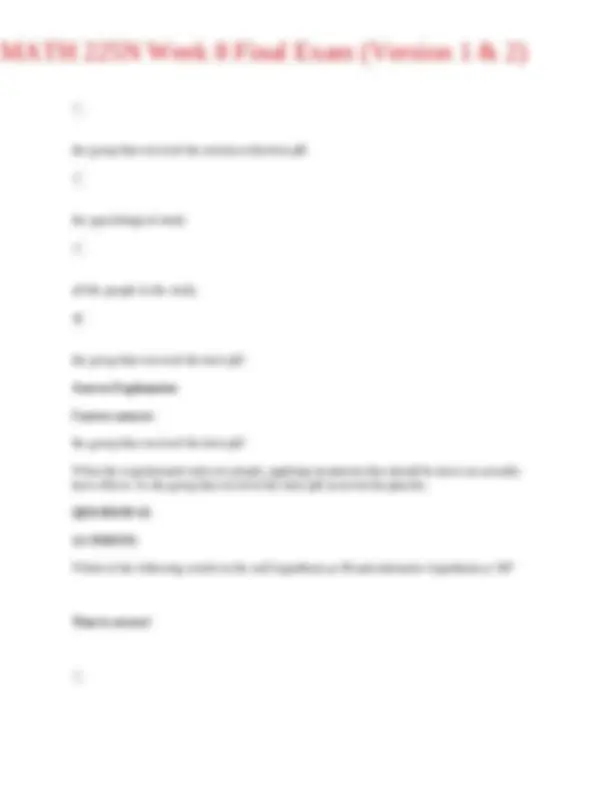
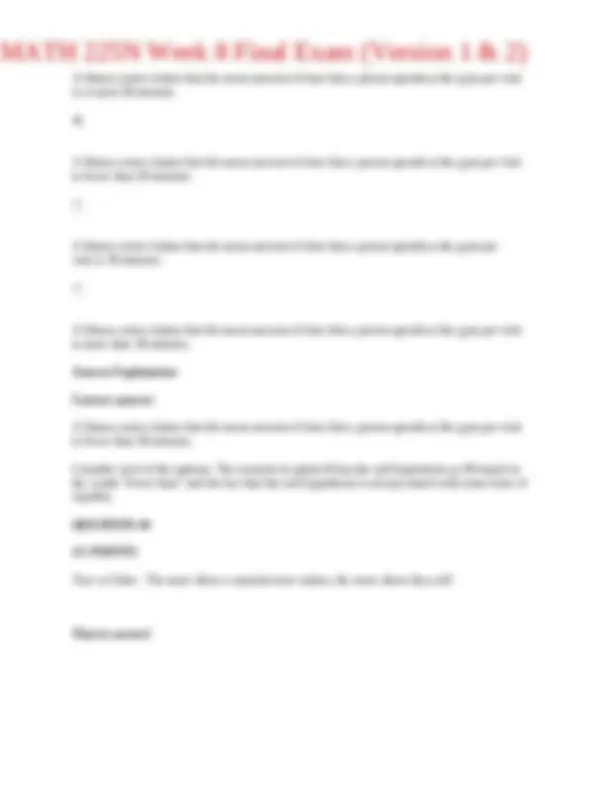
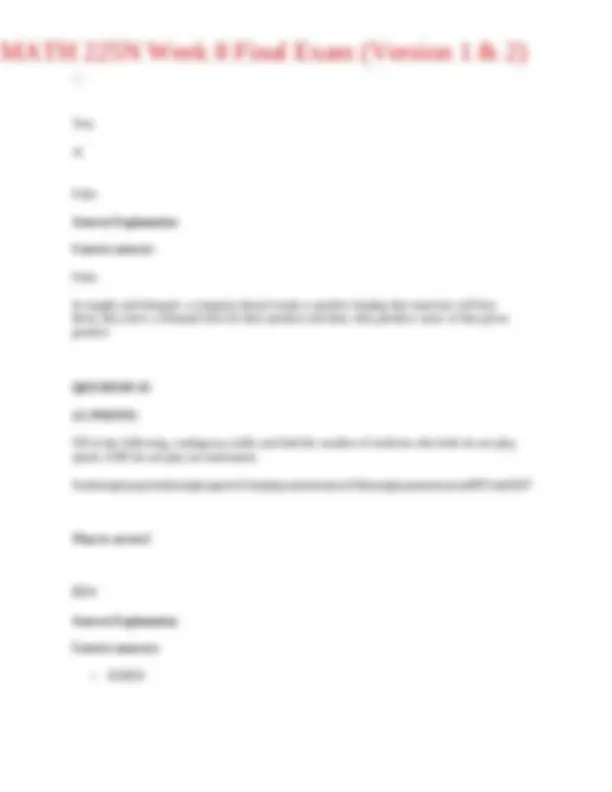
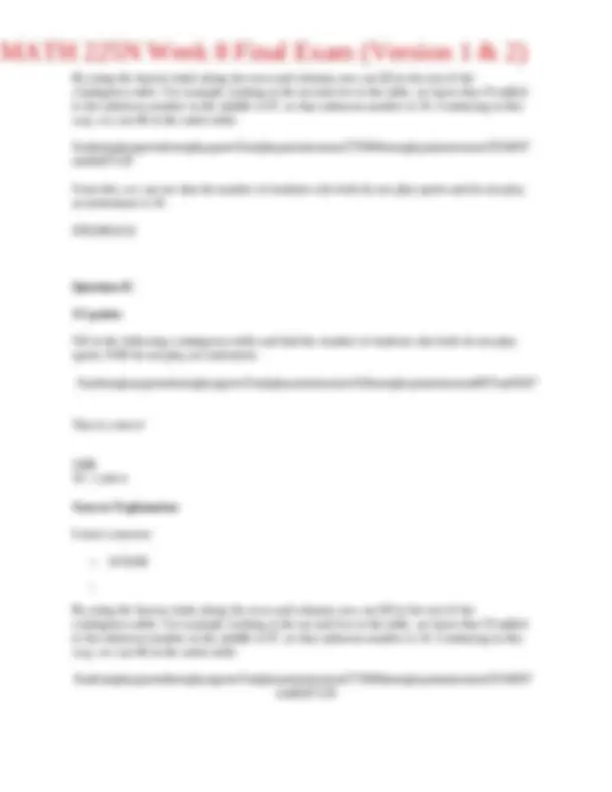
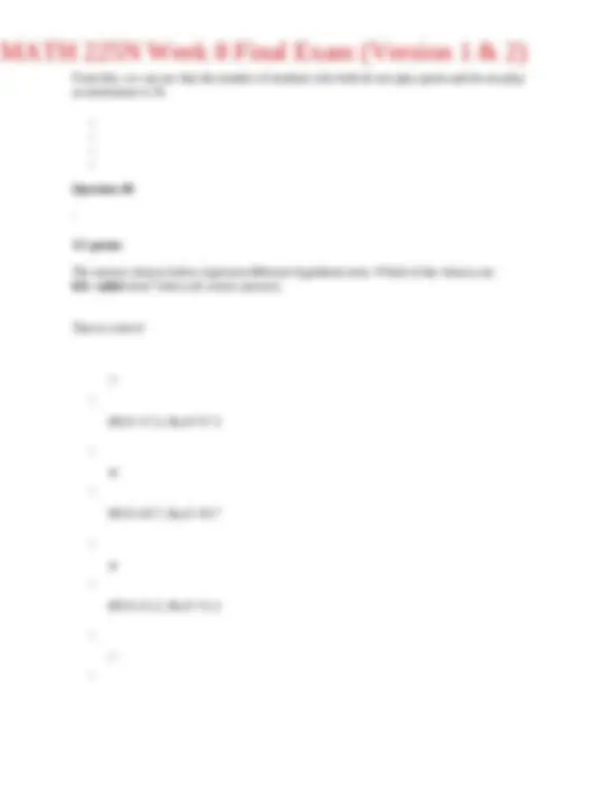
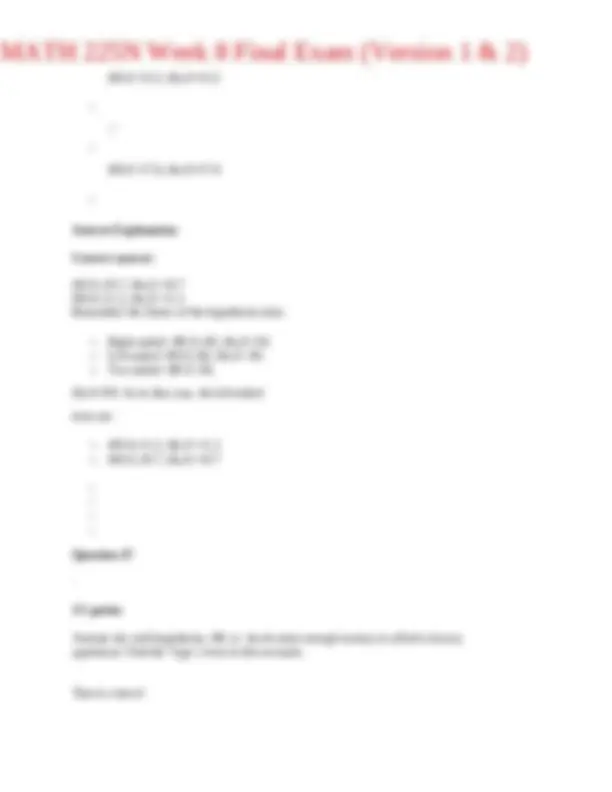
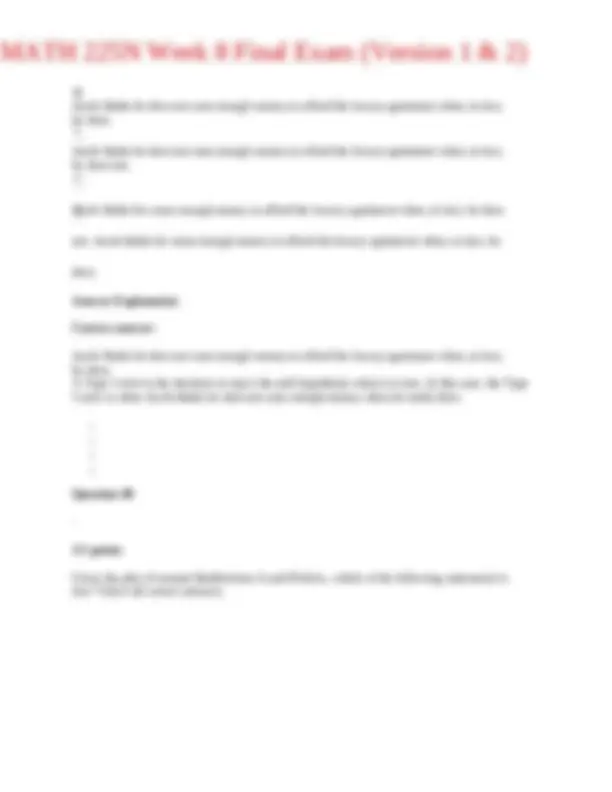
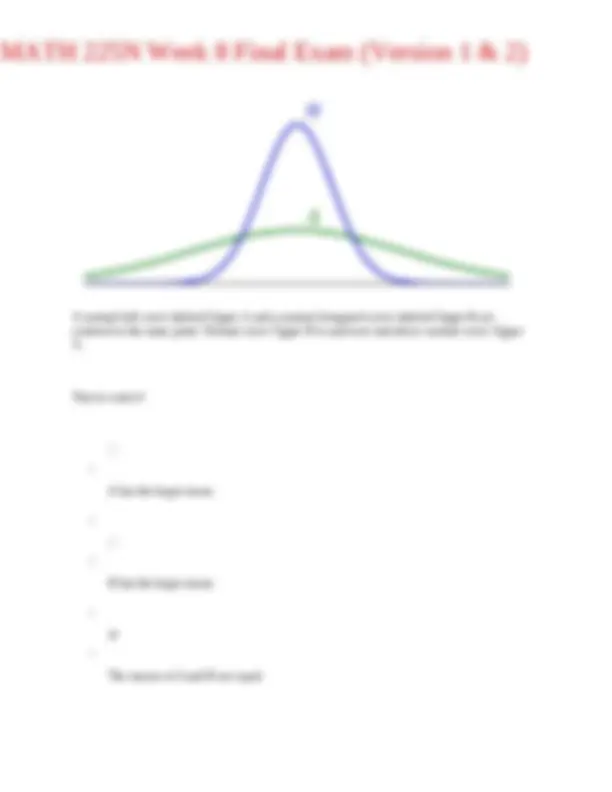
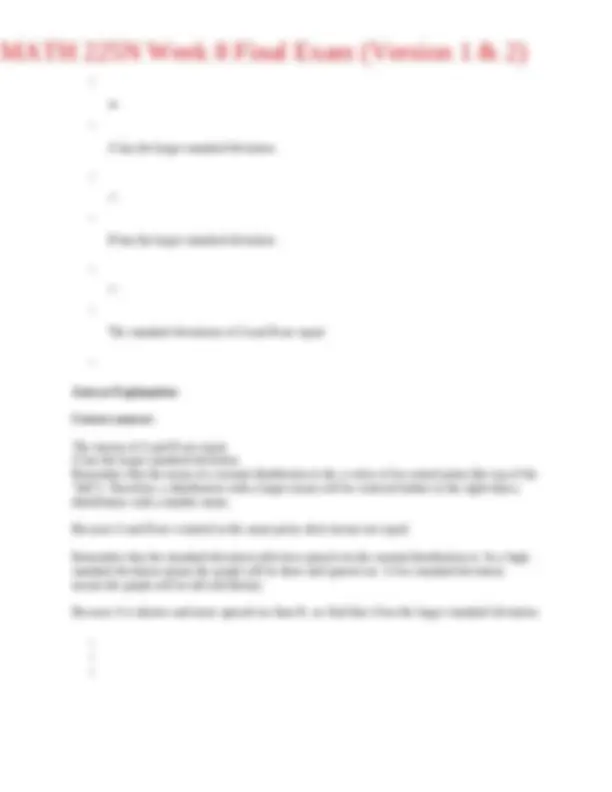
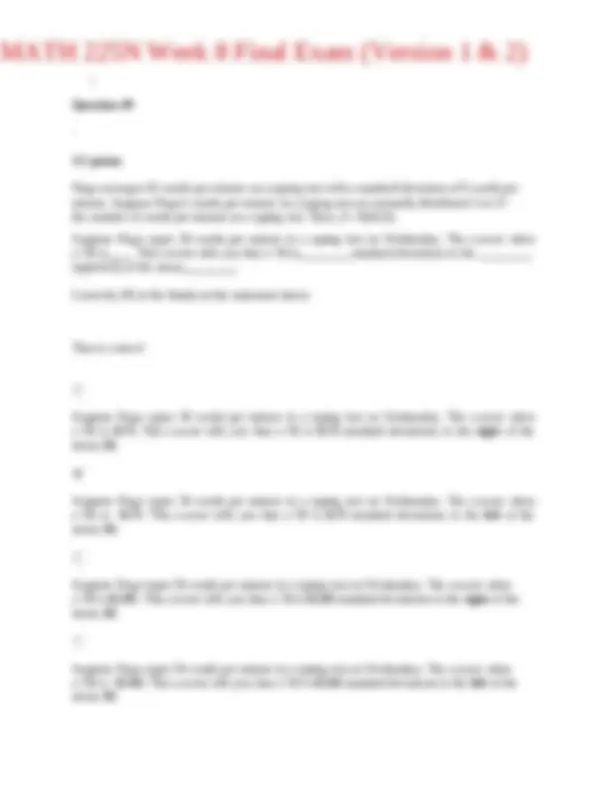
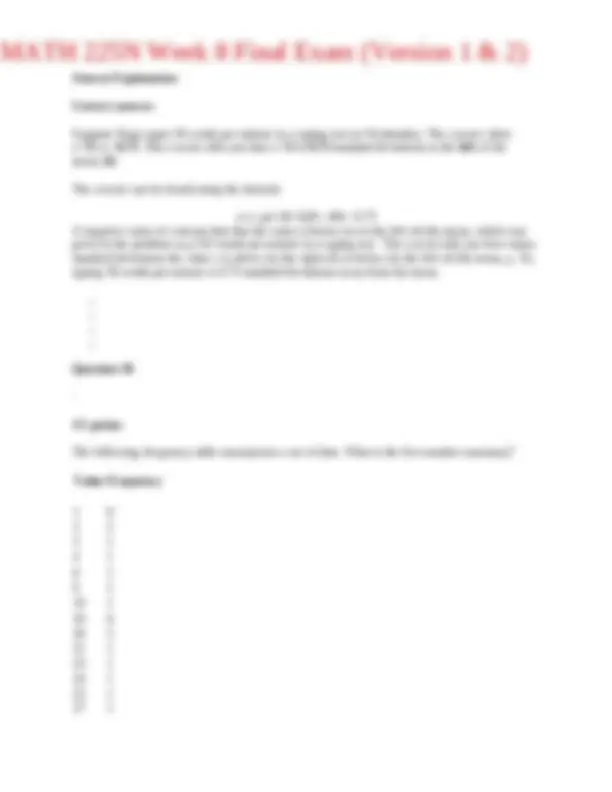
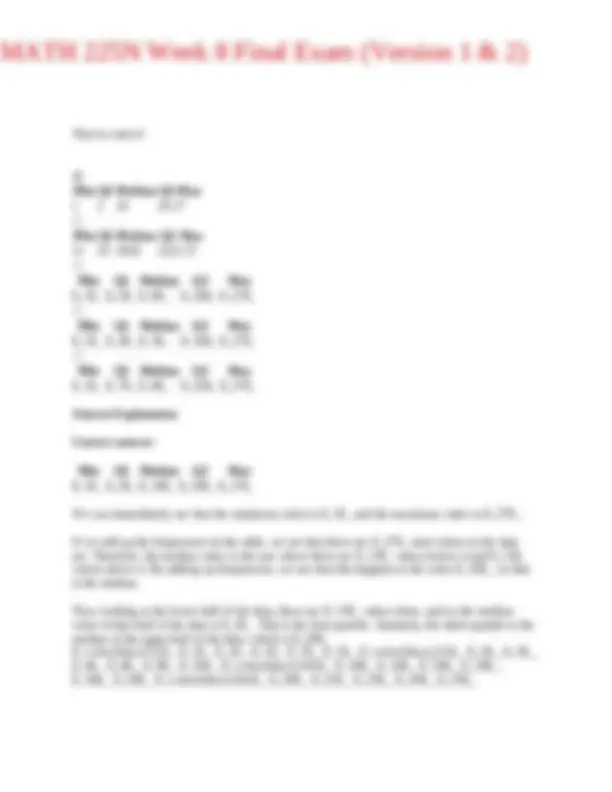
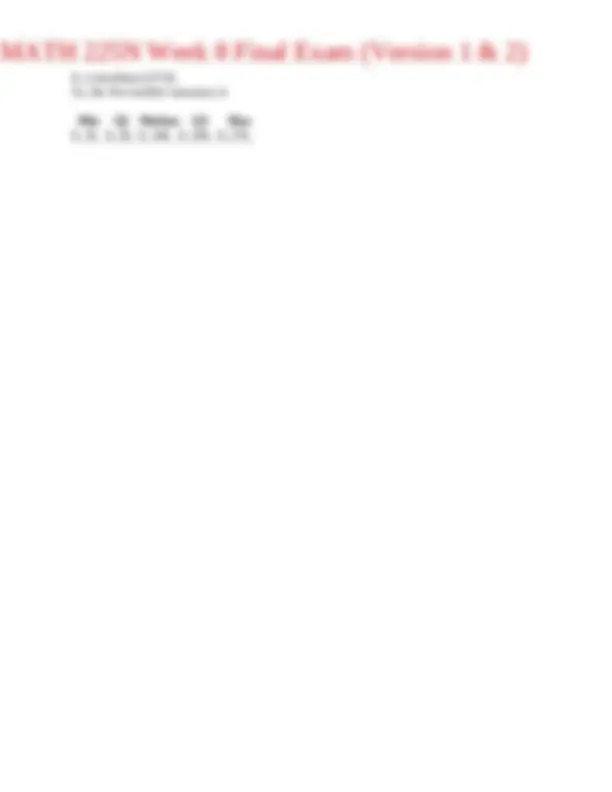


Study with the several resources on Docsity

Earn points by helping other students or get them with a premium plan


Prepare for your exams
Study with the several resources on Docsity

Earn points to download
Earn points by helping other students or get them with a premium plan
Community
Ask the community for help and clear up your study doubts
Discover the best universities in your country according to Docsity users
Free resources
Download our free guides on studying techniques, anxiety management strategies, and thesis advice from Docsity tutors
A series of exercises and solutions related to hypothesis testing in statistics. It covers various aspects of hypothesis testing, including formulating null and alternative hypotheses, calculating test statistics, determining p-values, and making decisions based on significance levels. The exercises are designed to reinforce understanding of key concepts and provide practical application of hypothesis testing techniques.
Typology: Exams
1 / 77

This page cannot be seen from the preview
Don't miss anything!






































































Question 1 1/1 points A fitness center claims that the mean amount of time that a person spends at the gym per visit is 33 minutes. Identify the null hypothesis, H 0, and the alternative hypothesis, Ha , in terms of the parameter μ. That is correct! H 0: μ ≠33; Ha : μ = H 0: μ =33; Ha : μ ≠ H 0: μ ≥33; Ha : μ < H 0: μ ≤33; Ha : μ > Answer Explanation Correct answer: H 0: μ =33; Ha : μ ≠ Let the parameter μ be used to represent the mean. The null hypothesis is always stated with some form of equality: equal (=), greater than or equal to (≥), or less than or equal to (≤). Therefore, in this case, the null hypothesis H 0 is μ =33. The alternative hypothesis is contradictory to the null hypothesis, so Ha is μ ≠33. Question 2 1/1 points The answer choices below represent different hypothesis tests. Which of the choices are right- tailed tests? Select all correct answers. That is correct!
Answer Explanation Correct answer: H 0: X ≤3.8, Ha : X >3. H 0: X ≤7.4, Ha : X >7.
structures were built without permits when, in fact, more than 15% of the structures were built without permits.
Question 4 1/1 points Suppose a chef claims that her meatball weight is less than 4 ounces, on average. Several of her customers do not believe her, so the chef decides to do a hypothesis test, at a 10% significance level, to persuade them. She cooks 14 meatballs. The mean weight of the sample meatballs is 3.7 ounces. The chef knows from experience that the standard deviation for her meatball weight is ounces.
The hypotheses were chosen, and the significance level was decided on, so the next step in hypothesis testing is to compute the test statistic. In this scenario, the sample mean weight, x ¯=3.7. The sample the chef uses is 14 meatballs, so n =14. She knows the standard deviation of the meatballs, σ =0.5. Lastly, the chef is comparing the population mean weight to 4 ounces. So, this value (found in the null and alternative hypotheses) is μ 0. Now we will substitute the values into the formula to compute the test statistic: z 0= x ¯− μ 0 σn √=3.7−40.514√≈−0.30.134≈−2. So, the test statistic for this hypothesis test is z 0=−2.24.
Question 5 1/1 points What is the p -value of a right-tailed one-mean hypothesis test, with a test statistic of z 0=1.74? (Do not round your answer; compute your answer using a value from the table below.) z1.51.61.71.81.90.00 0.9330.9450.9550.9640.971 0.01 0.9340.9460.9560.9650.972 0.02 0.9360. 0.9570.9660.973 0.03 0.9370.9480.9580.9660.973 0.04 0.9380.9490.9590.9670.974 0.05 0.9390. 0.9600.9680.974 0.06 0.9410.9520.9610.9690.975 0.07 0.9420.9530.9620.9690.976 0.08 0.9430. 0.9620.9700.976 0.09 0.9440.9540.9630.9710. That is correct! 0 point 0 4 1$$ 0 point 0 4 1 - correct Answer Explanation Correct answers:
The p -value is the probability of an observed value of z=1.74 or greater if the null hypothesis is true, because this hypothesis test is right-tailed. This probability is equal to the area under the Standard Normal curve to the right of z =1.74.
Do not reject the null hypothesis because the p -value 0.0401 is greater than the significance level α =0.04. Reject the null hypothesis because the p -value 0.0401 is greater than the significance level α =0.04. Reject the null hypothesis because the value of z is negative. Reject the null hypothesis because |−1.75|>0.04. Do not reject the null hypothesis because |−1.75|>0.04. Answer Explanation Correct answer: Do not reject the null hypothesis because the p -value 0.0401 is greater than the significance level α =0.04. In making the decision to reject or not reject H 0, if α > p -value, reject H 0 because the results of the sample data are significant. There is sufficient evidence to conclude that H 0 is an incorrect belief and that the alternative hypothesis, Ha , may be correct. If α ≤ p -value, do not reject H 0. The results of the sample data are not significant, so there is not sufficient evidence to conclude that the alternative hypothesis, Ha , may be correct. In this case, α =0.04 is less than or equal to p =0.0401, so the decision is to not reject the null hypothesis.
QUESTION 7 1/1 POINTS A recent study suggested that 81% of senior citizens take at least one prescription medication. Amelia is a nurse at a large hospital who would like to know whether the percentage is the same for senior citizen patients who go to her hospital. She randomly selects 59 senior citizens patients who were treated at the hospital and finds that 49 of them take at least one prescription medication. What are the null and alternative hypotheses for this hypothesis test? That is correct!
{H0:p=0.81Ha:p>0. {H0:p≠0.81Ha:p=0. {H0:p=0.81Ha:p<0. {H0:p=0.81Ha:p≠0. Answer Explanation Correct answer: {H0:p=0.81Ha:p≠0. First verify whether all of the conditions have been met. Let p be the population proportion for the senior citizen patients treated at Amelia's hospital who take at least one prescription medication.
Ha : p ≠ 0. Find the p-value for this hypothesis test for a proportion and round your answer to 3 decimal places. The following table can be utilized which provides areas under the Standard Normal Curve: That is correct! $$P-value=0. Answer Explanation Correct answers:
The decision criteria is then as follows: If the p-value is less than or equal to the given significance level, then the null hypothesis should be rejected. So, if p≤α, reject H0; otherwise fail to reject H0. When we have made a decision about the null hypothesis, it is important to write a thoughtful conclusion about the hypotheses in terms of the given problem's scenario. Assuming the claim is the null hypothesis, the conclusion is then one of the following:
Which answer choice shows the correct null and alternative hypotheses for this test? That is correct! H0:p=0.6; Ha:p>0.6, which is a right-tailed test. H0:p=0.5; Ha:p<0.5, which is a left-tailed test. H0:p=0.6; Ha:p≠0.6, which is a two-tailed test. H0:p=0.5; Ha:p≠0.5, which is a two-tailed test. Answer Explanation Correct answer: H0:p=0.5; Ha:p≠0.5, which is a two-tailed test. The null hypothesis should be true proportion: H0:p=0.5. Becky wants to know if the true proportion of heads is different from 0.5. This means that we just want to test if the proportion is not 0.5. So, the alternative hypothesis is Ha:p≠0.5, which is a two-tailed test. QUESTION 12 1/1 POINTS John owns a computer repair service. For each computer, he charges $50 plus $45 per hour of work. A linear equation that expresses the total amount of money John earns per computer
Answer Explanation Correct answer: The independent variable (x) is the amount of time John fixes a computer. The dependent variable (y) is the amount, in dollars, John earns for a computer. John charges a one-time fee of $50 (this is when x=0), so the y-intercept is 50. John earns $45 for each hour he works, so the slope is 45. The independent variable (x) is the amount of time John fixes a computer because it is the value that changes. He may work different amounts per computer, and his earnings are dependent on how many hours he works. This is why the amount, in dollars, John earns for a computer is the dependent variable (y). The y-intercept is 50 (b=50). This is his one-time fee. The slope is 45 (a=45). This is the increase for each hour he works. QUESTION 13 1/1 POINTS Ariana keeps track of the amount of time she studies and the score she gets on her quizzes. The data are shown in the table below. Which of the scatter plots below accurately records the data? Hours studying Quiz score 1 5 2 5 3 7 4 9 5 9
That is correct! A scatterplot has a horizontal axis labeled Hours studying from 0 to 6 in increments of 1 and a vertical axis labeled Quiz score from 0 to 10 in increments of 2. The following points are plotted: left-parenthesis 1 comma 5 right-parentheses; left-parenthesis 2 comma 5 right- parentheses; left- parenthesis 3 comma 7 right-parentheses; left-parenthesis 4 comma 9 right-parentheses; left- parenthesis 5 comma 9 right-parentheses. All values are approximate.
A scatterplot has a horizontal axis labeled Hours studying from 0 to 6 in increments of 1 and a vertical axis labeled Quiz score from 0 to 9 in increments of 1. The following points are plotted: left-parenthesis 1 comma 5 right-parentheses; left-parenthesis 2 comma 5 right-parentheses; left- parenthesis 3 comma 7 right-parentheses; left-parenthesis 4 comma 8 right-parentheses; left- parenthesis 5 comma 8 right-parentheses.
A scatterplot has a horizontal axis labeled Hours studying from 0 to 6 in increments of 1 and a vertical axis labeled Quiz score from 0 to 12 in increments of 2. The following points are plotted: left-parenthesis 1 comma 5 right-parentheses; left-parenthesis 2 comma 5 right- parentheses; left- parenthesis 3 comma 8 right-parentheses; left-parenthesis 4 comma 8 right-parentheses; left- parenthesis 5 comma 11 right-parentheses. All values are approximate. Answer Explanation Correct answer: